#backgrounds and perspective have been shot out of a window
Text
Timekeeper got the ability to get himself a human form?? I don’t think the parable handles that well.
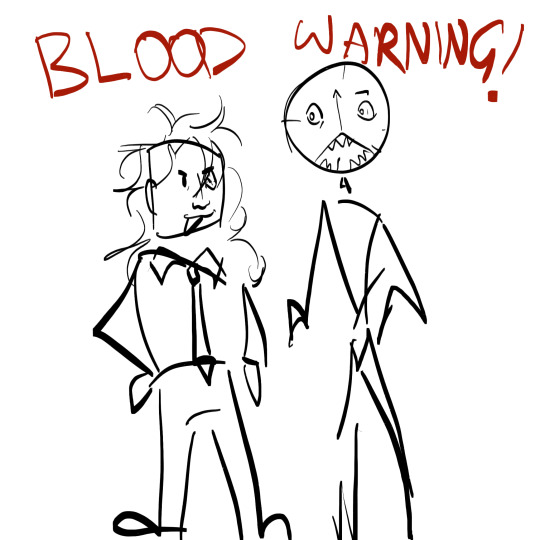

Down here is just me mucking around with stuff T-T



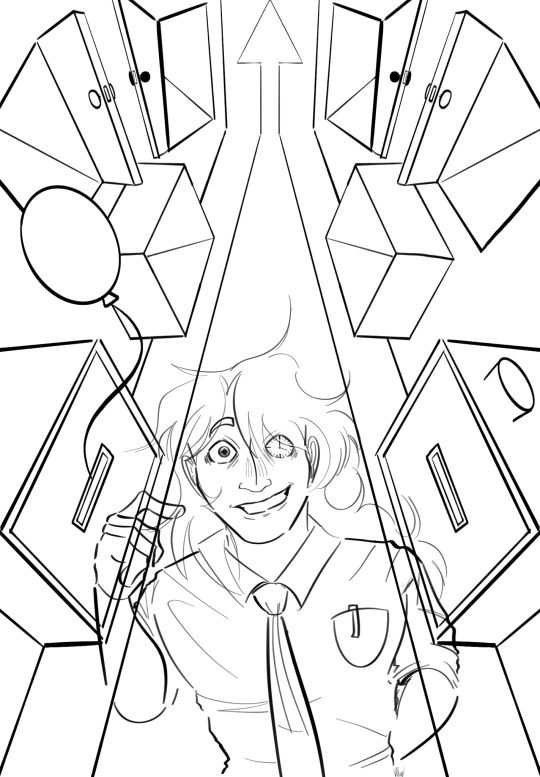
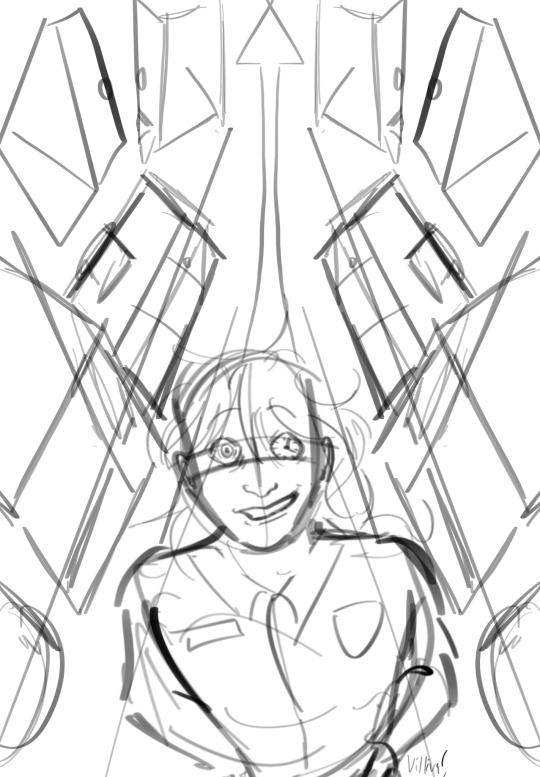
#the stanley parable#tspud#stanley parable#tsp#tsp timekeeper#timekeeper#the stanley parable timekeeper#TK#tsp narrator#tsp stanley#wanted to give clock man a human form#or a past/post parable form?#idk#anywhooo#backgrounds and perspective have been shot out of a window
143 notes
·
View notes
Text
A Theory on the Kayanos' Murders
CW Violent murder, blood, mention of dismemberment
Hello members of the jury! I'm currently writing a few posts regarding the prisoners' murders and forgiveness and all that, so I decided I would explain my full theory on what the Kayanos' murders are, since while it's nothing out of the norm (I think), my exact interpretation gets a bit specific. And thus, I want to put all the evidence I have for my claims in one post so I don't sound insane when discussing these two.
(Yes despite what my previous posts may imply I actually believe Twokoto now lol. I still think Trikoto is perfectly fine, I just think Twokoto makes a bit more sense currently)
Again, it's nothing too wild; I believe Mikoto killed someone on the side of the road, the trauma from that caused John to be 'born', and then John killed at least two other people because he knew they were causing Mikoto trouble.
Claim 1: John killed people
A big part of this post is going to rely on the windows in Double. In case you're not aware, it's generally agreed that white windows are related to Mikoto while black windows are related to John. It's easy to tell from the first chorus, the start of the second verse, and the second chorus. Mikoto to the left, John to the right.
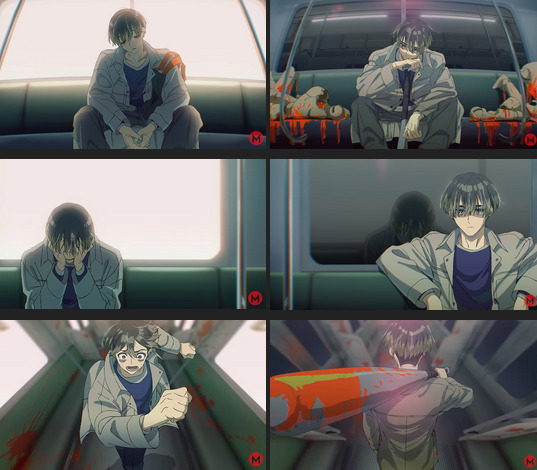
Additionally, when the windows are white, the train seems to be moving to Mikoto's left to the right (perspective from the first chorus), while when the windows are dark it moves from John's right to his left. This gives the impression that Mikoto and John are sitting across from each other, with Mikoto on the left side of the train and John on the right side. Here, I made a graph to help with the perspective because it is a bit mindfucky.
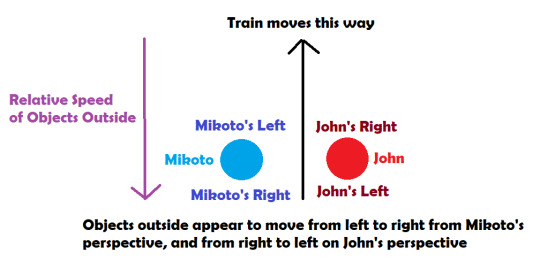
(Clarification: when I say "Mikoto's perspective" I actually mean our perspective while looking at Mikoto. Same with John. Apologies for the confusion)
Of course, that's assuming they actually are on the same train, going in the same direction, but I don't think that's too wild an assumption to make.
It's important to note this doesn't have anything to do with the window colors, which are exclusively used to differentiate alters, with the exception of the very end where John is seen with white windows long story. Rather, this perspective thing is a surprise tool which will help us later.
Anyways, now that we know the window thing, it's not hard to see how John has killed at least one person.
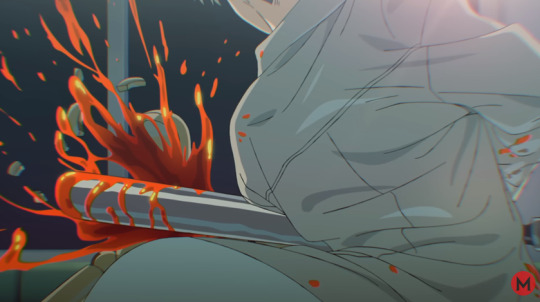
I mean, yeah. He sure do be killing in that shot. Black windows, so this is John. There's also this:

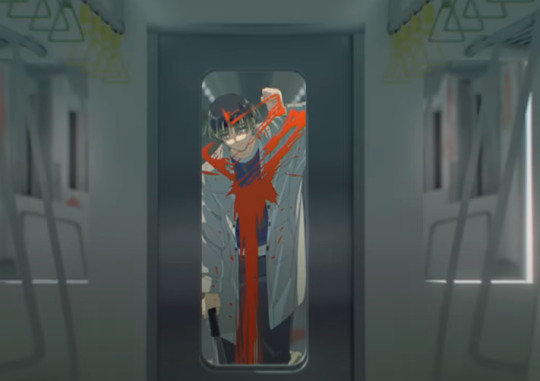
Although the kill itself has white windows in the background, the train compartment it happens in has dark windows.
Plus there's the whole "I saved you, right?" in the past tense. It can't be referring to John taking the fall for Mikoto's murder (we'll get there), since Mikoto hasn't been saved from that yet. Instead, it sorta has to be about John previously killing people that were stressing Mikoto out. Especially when looking at other lines like:
[Double]
You’re overdoing it, you’re already broken
But if you persist, I guess it’s my job to keep things on an even keel
Me, the other you
I’ll take it all on
The use of present tense in "you're overdoing it" implies this is being sung at a time when Mikoto is overworking, and it's now that John will "keep things on an even keel." Combined with him picking up the metal bat here, it seems he's talking about killing to ease Mikoto's issues.
Which, speaking of, I should probably say why John would kill anyone.
Claim 2: John's Motivations
[Neoplasm]
Es: Can I ask… why you killed them?
John: They annoyed me.
Es: Who did you kill?
John: Just someone who was walking around nearby.
Es: … How many did you kill?
John: Can't remember. I was first born back then, you know. It's kinda fuzzy.
Now, these claims aren't the most trust-worthy, but we'll get there when we get there. For now, all we have as a stated motive is "they annoyed [me]" (no pronoun used, it's ambiguous who they actually annoyed) and "to save Mikoto." The good news is that we actually did sorta see a situation where John tried to kill someone, meaning we can get an idea of what his modus operandi is.
I'm referring to the point in John Doe where John attacks Es.
[John Doe]
Mikoto: I became a murderer… without even knowing it…?
There's no way, no way…
Es: Let's give it some time. The threads of your memory might untangle themselves eventually.
Mikoto:*Gasping*
Es: A murderer without memory of killing… in which case, how should I think of you…
Hey, Mikoto–
John: AAAAAAAARGH!!!!!!
Es does absolutely nothing between the time John starts fronting and when John attacks them. And if you look further, Es doesn't do much else. That means either John has some idea of what was going on before he started fronting, or he can feel Mikoto's resentment even though he isn't the one fronting.
This is where I acknowledge I am not an expert in DID, I'm not a system, and because of that there is a high chance I get stuff wrong, please correct me if I say anything stupid!
Although I unfortunately can't find any better sources for this than some Reddit threads, from what I understand it's possible for one alter to feel the emotions of a different alter who isn't fronting. This means John could have known Mikoto was getting really frustrated with Es, and decided Es had to die for that. However, it's unclear how much John knew about the situation, since he never says anything too specific.
As a result, it's possible John is willing to attack people because he can feel Mikoto hates them, even if he isn't fully sure why Mikoto might be frustrated at them. On the other hand, perhaps John does retain memory of what Mikoto goes through even when Mikoto is fronting. Again, I can't find good sources on how this works, but from what I've seen some systems do have alters which can share memories to an extent. I really hope I'm not saying anything horrendously stupid lol.
Anyways, the point I'm trying to make is that regardless of how it happens, John's desire to kill his victim(s) comes from Mikoto's frustrations with those people.
[Neoplasm]
John: …! … I think… I might be the person Mikoto wishes he was.
The person who stubbornly stands his ground, who doesn't cry himself to sleep from stress, who gives people their payback.
The fact he's represented by the Devil card, which is associated with people's darkest desires, supports the idea his actions are an extension of Mikoto's wishes.
This can also be inferred from the "neuron" scene in Double. You know the one, the one that goes "Doesn't matter if you didn't wish for it, can't get rid of me now". I interpret those silver star things to be representative of neurons, and it's animated in the way it is to represent Mikoto's thoughts (the words in blue) reaching John's conscious at the bottom (the red). I hope that makes sense.
So in short, I believe John found out Mikoto was getting bothered by certain people, and that's why he killed them.
Claim 3: Mikoto killed a guy
Alright so now the harder one to prove. Let me add up all the evidence.
Point #1: Mikoto is the Milgram prisoner, not John
This one is pretty straightforward. Since Milgram doesn't gather every single murderer in the world, John not being a prisoner doesn't mean he didn't kill. But the inverse is potentially true; if Mikoto is a prisoner, then he must have killed someone. Unless there's more alters and one of them is the prisoner, this makes some sense.
The counter-argument is that Milgram is very clearly not designed for systems, so it's possible Mikoto is only the prisoner because he's the host and no other reason. Still, it's worth keeping in mind.
Point #2: A murder on light windows
Take a look at this scene from Double.
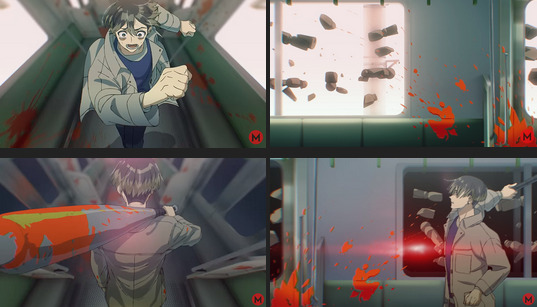
As you can see, the way this is framed, it looks as if Mikoto is running away from John. Down to the horror movie motifs of "victim running - persecutor walking." This time, the windows on both sides of Mikoto are white, while the windows on both sides of John are black, instead of there being white and black across from each other.
Looking at the scene, which I can't really show you with still images and will need you to confirm yourself, is that John and Mikoto are moving in the same direction as the train. You can tell based on the relative speed of the objects outside. And yet, there's body parts outside of the train, which move from the front to the back. On the white windows. Which represent Mikoto. And there's an entire window between the left of the screen (where for all we know the windows could change) and where the blood appears. Here's a diagram.
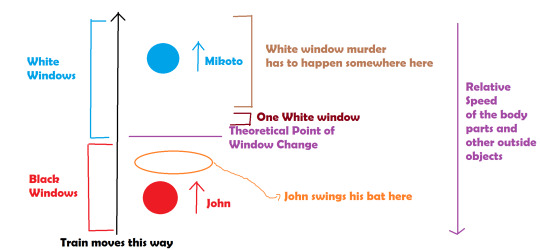
So, uh, Mikoto? Who the hell killed that guy? It certainly wasn't John, especially because the body parts are outside. John was the one who got onto the train (see: cigarette), so I would argue a murder outside could imply it was performed by Mikoto, who notably doesn't usually ride trains. Although I'm not sure that reasoning makes sense to anyone but me.
However, the body being outside presents a much bigger issue for Mikoto's innocence. When John swings, and apparently causes something similar to happen, he's inside. We don't see the mannequin he supposedly hits, and God knows how the pieces ended up outside. Not to mention he for some reason swings at where the legs would be, instead of at the head like all the other attacks we see.
My point here is that this murder makes very little sense if John is supposed to have caused it. Because of all that, to me, this represents John taking the fall for Mikoto's one kill. Unlike the other John murders, which show the "victim" and make physical sense, this one doesn't show the victim and has inconsistencies because John didn't do it. The murder was originally in the white windows, and John is scrambling to make it look like it happened on the black windows, even though that doesn't really work as shown by the diagram above.
Am I taking these scenes too literally? Maybe, but even symbolically, what does it mean if blood appears when the windows are white? Surely there's at least a chance it's Mikoto doing this murder.
Point #3: 3rd Anniversary artwork
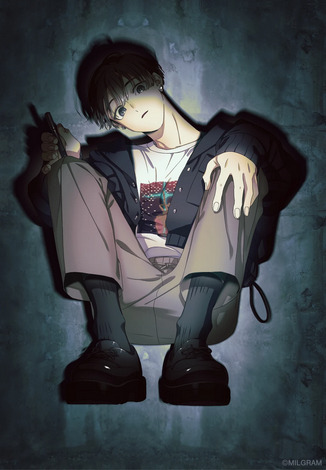
Let's first establish what the 3rd anniversary art usually represents. It's been pointed out by many before me that these pieces are closely connected to the prisoners' murders. This is clearest with Muu, Amane and Kotoko.

Muu is wearing her school outfit, but she has a shoe off, just like she did when she killed Rei.
Amane is wearing her Magic outfit, but she's holding her thunder wand, which places this image near her murder. Specifically right before her murder, as she's still wearing her black bow tie instead of her cloud medal thing.
Kotoko is holding her Jacques Roulet cap, a hat she usually only uses alongside her blue and yellow jacket. The only exception is during her murder, where she's wearing the outfit we see in the anniversary artwork while the cap rests on the floor.
The others all hold up with this hypothesis. Yuno is wearing her yellow shirt, the one she's wearing in Tear Drop near the end when she lets out a tear, presumably representative of her murder. Fuuta is wearing the hoodie and mask he wears throughout Bring it On, and he's holding his phone, which does fit doxxing Killcheroy even though it's more generic. Kazui and Mahiru are wearing the outfits they wear in the scenes of their respective lovers' death. Haruka wears his Weakness plain white outfit, which could point to any moment of his narrative, including the murder. And the only times we see Shidou physically kill (cutting off flowers), he's wearing the floral jacket he wears in the artwork.
I want to be clear. For most of them, the relation to the murder could just be because they don't have many outfits in their MVs. However, Muu's, Amane's and Kotoko's feel extremely intentional, and the fact none of the other ones contradict this trend makes it feel like it could be universal.
Which gets us to Mikoto's artwork. And in his artwork, he's holding (what looks to be) a vape pen. John smokes cigarettes, so that's definitely Mikoto. In the murder artwork. So, uh. Yeah. That certainly feels like he must have killed at least one person.
The only small contradiction is that his beanie is nowhere to be found, which is why I don't consider this definitive. However, the fact they specifically chose to make Mikoto hold a vape pen when every other prisoner can easily be connected to the murder feels... intentional.
Point #4: Swing and a hit
More Double screenshots.
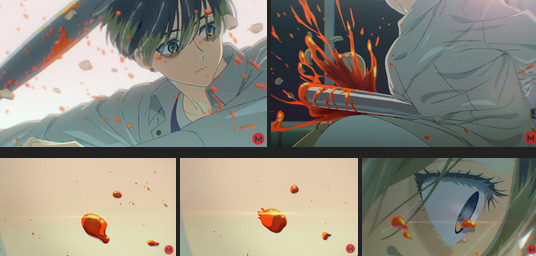
So a few weird things. For starters, let's get something straight: there's two murders depicted here. Notice how the first image shows a Kayano swinging with a right-handed swing, then the second shows John (black windows) doing a left-handed swing. The important thing isn't the type of swing, but the fact they're different.
(I know I made some posts at one point about dominant hands, but as my beloved and extremely smart mutual accirax pointed out a lot of the time Milgram characters switch hands because it looks better for the animation, so they're sorta ambidextrous by default lol)
It's not hard to realize if you try to follow the motion yourself. The only way this works is if he swings one way, then the other, which doesn't fit the fact all mannequins are usually destroyed after just one hit. And it's not like it's an animation issue: you can literally fix this by flipping the image.
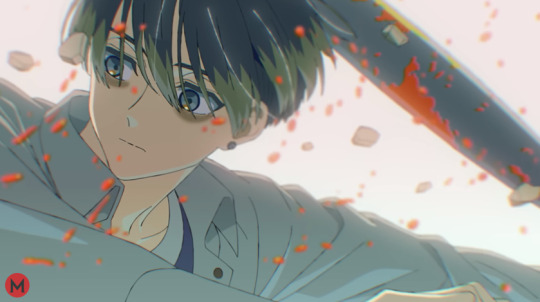
... Okay it does look a bit awkward but I think it works well enough. It's less weird than the swing changing mid-way through.
To me, this is similar to what I talked about before with the white window murder. John's subconscious trying to convince itself this was John by thinking back to a different murder that has nothing to do with this one. I have no idea if that makes sense.
And then there's the fact the background in the first image is pure white. This doesn't have to mean the one fronting is Mikoto, but why leave it ambiguous if it would have worked perfectly fine with black windows in the background?
Hell, actually, who says we're on the train? This is the only scene in the entirety of Double (apart from the mom phone call) where it's unclear whether we're on the train or not. And as we established, if there is a murder outside the train, it would probably be Mikoto murdering.
And don't get me started on the blood, the eye, and the noise in the background.
First, the background noise in this scene famously has baby crying noises. Could it be we're witnessing John's "birth"? Because if that's the case, then either John was born during the phone call with the mother, which doesn't make a whole lot of sense if you think about it, or John was born during or after the murder on screen.
This actually fits with the close-up of the eye. Despite the fact that "right-hand swing Kayano" seems pretty chill as he attacks the mannequin, right as the scene end, his pupils become smaller as if he's surprised by something. But what would he be surprised about? To me, it feels like "right-hand swing Kayano" was perhaps dissociating (I think that's the right term, please correct me if I'm wrong), and then John is born. Naturally, John gets surprised by the fact the first thing he sees is a dead person, explaining the odd reaction.
Funnily enough, this is actually supported by the very strange blood behavior. It's hard to describe, so bear with me. You see how there's one big orb at the center of the screen? And it starts with one small drop, which enters the orb, and then three small droplets come out the other side? Uh... Diagram?
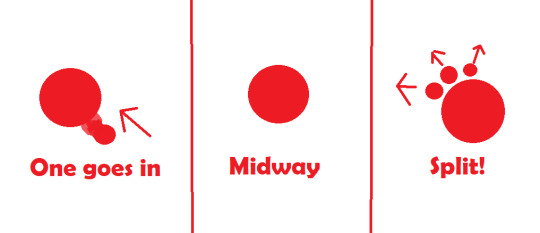
This isn't normal blood behavior, of course (<- not that I know what normal blood behavior actually is, but I know how liquids work and this ain't it). It's imagery of something splitting, which in the context of alters, fits alongside the baby noises and the weird reaction to murder. Although I fully acknowledge the blood thing falls into the territory of "am I reading too much into this or is Milgram just insane?", so you know. Take it with a few metric tons of salt.
(Funnily enough, it does split into three things. Trikoto win? It doesn't convince me, but the interpretation is valid)
To recap, we have a strange murder with a white background, possible misdirection by showing a completely unrelated murder performed by John, baby noises, imagery of something splitting, and a reaction to the murder which could support an alter being born in that very moment. All of this could imply this "right-hand swing murder" is the moment John is born, which would mean the actual murderer is Mikoto.
Point #5: The tarot spreads in MeMe
This one is very abstract, but it can definitely point to Mikoto murdering someone. Take a look at the two different spreads we see in the first chorus (the first one flashes twice but it's the same).
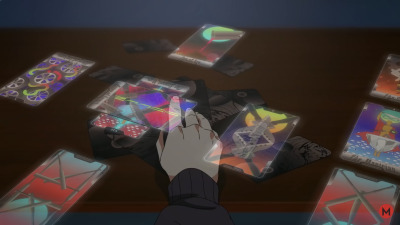

These things are really complicated, and I should probably do a post about them at some point, but I'm gonna focus on the main things, that being the changes between the two spreads.
For starters, we see that the "querent" card, the one in the middle of The Wheel, is the reversed Hanged Man. Since this is the portrait besides The Fool in the water world thing, it can be assumed the reversed Hanged Man represents Mikoto. Thus, these are his spreads.
Then, the Outcome card of the first spread is the Devil. Since the Devil card on its own also flashes after the second spread, it can be assumed the Devil is also the Outcome of the second spread, as that's the only card which is not visible. Then, as stated before, the Devil card is related to John. This means the Outcome of the situation depicted in these spreads is John. In other words, this is the situation which led to John appearing.
Now we have to establish how we're supposed to read these things. I've explained it in another post, but basically, the only way we can tell how we're supposed to read the cards in The Wheel is by knowing the order they're drawn, so we can determine if the meaning is based on position or draw order (long story). We can do this by looking at the final spread, where it appears the cards are drawn Bottom->Right->Left->Top. This doesn't exactly fit any common way of drawing them, so we read based on position. Aditionally, since this is Japanese media and the card to the right is drawn before the card on the left, middle row of The Wheel is Future<-Present<;-Past. And based on the way the upright Page of Pentacles is placed in the final spread, if the name of the card is to the left the horizontal card is upright, if not it's reversed. If that doesn't make any sense to you, don't worry too much about it, I'll walk you through the important parts. You want a diagram? No? Well, you're gonna get one so-

After clarifying that, we can see that in these two spreads, while most of everything remains consistent, the Future and the Conscious change, the Challenge flips, and the Attitude is revealed. Let's take it one step at a time.
Let's start with the first spread. In the Challenge position (horizontal middle), we have the upright Queen of Swords. This card can represent anything you want tarot reading is so annoying a couple of things, including an authority figure. In the Challenge position, it could indicate there is a lack of communication, that the querent is being too "cold", in the sense they're not expressing their emotions correctly.
Then, in the Conscious position, the thing Mikoto is actively working towards, we have the Ace of Cups. This card can represent new beginnings, new relationships, good fortune, basically "good new things are coming your way." However, there is a slight change between MeMe's Ace of Cups and the IRL version, which could change the meaning a bit.
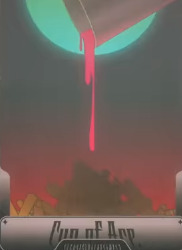

(No I don't know why MeMe calls it "Cup of Ace" that's just wrong lol)
As you can see, the IRL version has the water from the cup spilling on its own, while the MeMe version has the cup being intentionally spilt on top of a few mannequins. What I think this could mean: if you take the water spilling as a good thing (which is how it's usually interpreted, the idea is that spirituality is overflowing or something like that), the IRL version shows that new good things are coming no matter what, while the MeMe version has the water spilling intentionally because Mikoto is actively trying to cause new, good developments, such as new relationships (we'll get there). That's also why it's in the Conscious position, Mikoto is consciously trying to build a good new relationship.
After that, in the Future position, we have the reversed Wheel of Fortune. This can mean a lot of things, but it mainly has to do with a negative cycle in someone's life. In the Future position, then, this could mean a perpetuation of a negative cycle in Mikoto's life. Thus, in the first spread, if things continue as they are in that moment, the cycle of abuse Mikoto suffers at work will continue.
The Attitude card is obscured. I should note that this card can actually be read in a few different ways, but I think "Attitude" fits best here.
I'll also note the Subconscious card at the bottom of the Wheel ("so below") is the reversed Ten of Wands, which can represent Mikoto is feeling overburdened. Which we know certainly applies to his work.
Let's see here. Mikoto has a problem, possibly with someone in a position of authority, and feels overburdened. This could point to the Queen of Swords being a boss or a manager or something like that. It's upright because Mikoto isn't being direct enough in his desires; he's trying to 'play nice' and build up his relationship with the "Queen", that's what the Ace of Cups could represent. Not like I think his situation would actually improve if he told this "Queen" that he felt overworked, but still, the idea that Mikoto is bottling up his emotions definitely fits what we see of him. If he keeps it up, the cycle of (workplace) abuse will continue, represented by the reversed Wheel of Fortune. This would lead to Mikoto's darkest desires exploding; the Devil is the Outcome.
Let's move to the second spread. The Challenge is still the Queen of Swords, but reversed. This could imply the person giving Mikoto problems is still the same, but now the issue is that Mikoto is being too emotional. Again, there are a lot of ways to read these things, but I think that works.
The Conscious card is now the reversed Wheel of Fortune, which could mean Mikoto is actively aware of and possibly trying to break the negative cycle he's in.
The Future is now the Ace of Cups, which could imply there is a new relationship in Mikoto's future. This is where we acknowledge that the water can also represent consciousness, and in the MeMe version, it is being spilt over mannequins. And...
*sigh* The Ace of Cups can be associated with pregnancy, which fits the whole "newborn" thing John's got going on.
Indeed, I believe the new relationship in Mikoto's future is John, a "mannequin" receiving "consciousness." There is no other thing this could really allude to besides Milgram, which I don't think these spreads reference. However, if this really is about John, that would mean this spread is showing a situation before John's birth.
The Attitude card, which (according to most sources, there are conflicting reports on what the first card of The Wand is) represents how the querent is trying to achieve their Conscious goal, is the reversed King of Cups. This is most often associated with emotional repression, but it can also be connected to violence. Which is very interesting, because John has the same Attitude card in his spread. And we know how he approaches his issues (violence).
So all in all, Mikoto is having issues with an authority figure, and he's (possibly) being emotional about it. He's trying to break out of a negative cycle, and he's doing this either by repressing his emotions or by pulling a John (violence). In the future, this will lead to John's birth, which is why the Outcome is still implied to be the Devil.
This, by itself, doesn't necessarily imply murder. Again, the Attitude could be emotional repression and not violence. The weird thing is that the spread changed. And that means something had to happen to get the Future to change. The change can't have been John being born; that's still in the Future. And the thing we know happened is that the Conscious goal Mikoto was working towards changed, from wanting a prosperous new beginning or relationship to destroying an existing cycle.
Because of that, to me, it feels like the change between the first spread and the second is that Mikoto decided to let his emotions take over (reversing the Queen of Swords) and killed (reversed King of Cups) the authority figure who was causing him trouble, and this caused John to be born.
The final thing to note is that John's Past card is the Wheel of Fortune (upright). This could be read to mean the situation leading up to John's current situation is the destruction of a cycle, which fits the idea that Mikoto tried to destroy it before John was born.
Is this definitive evidence? Hell no! Tarot readings are so ambiguous that I'm pretty sure you can read these to mean whatever the hell you want them to mean. This is just my take on it, I don't even necessarily consider it good evidence because again, if you just take different meanings from the cards you can get whatever. But it's still something.
Point #6: John's insistence
Let's see what John says about the murders again.
[Neoplasm]
Es: Can I ask… why you killed them?
John: They annoyed me.
Es: Who did you kill?
John: Just someone who was walking around nearby.
Es: … How many did you kill?
John: Can't remember. I was first born back then, you know. It's kinda fuzzy.
So, as stated, John may have killed people without fully knowing why Mikoto was angry at them, but that doesn't mean this makes perfect sense. We know their victims weren't just "someone who was walking around nearby". Unless Mikoto regularly carries around a metal baseball bat for some god-forsaken reason, there must have been some kind of premeditation at play. John has to at least be hiding the real reasons for the murders, possibly because Mikoto might consider them shameful (more on that in a bit). This opens the door to the possibility he's hiding more than just that, and that makes a lot of his other claims seem a bit... desperate.
[Neoplasm]
John: From [Mikoto's] point of view, he's being blamed for a crime he can't even remember.
Es: If that's the truth, then… you're the one who committed the murder?
John: Yeah, it's me. I killed them off.
Es: …
John: So Mikoto really didn't do it.
Es: Is this really something that works that conveniently?
John: Just put yourself in Mikoto's shoes for a moment!
He was bottling up all his stress! He kept dealing with it all by himself the whole time, until it exploded!
It's not like he just decided that he wanted to hurt somebody!
Es: …
John: He's not the type of person who could do stuff like that! He always looks out for others, always reads the room, always tries to get along with people around him! He can't do stuff like that… He was on the verge of exploding!
That's why I was born. It's terrible, isn't it? My other self didn't do anything!
Es: Even if that's true… Even if it wasn't what Mikoto wanted – someone's life was still lost.
[...]
John: I'm the one who did it! Mikoto didn't do it! You know that because of MILGRAM! I don't care about the law, I want to know what you think!
Es: …
John: Please… forgive Mikoto. I'm the one who did it.
The amount of times John tries to take the fall for every single murder is so insane it makes it sound suspicious. Why does he say it so much?
Still, I'll be honest, this might just be confirmation bias, as a lot of these lines can still absolutely be read with the interpretation that John is the only killer.
John: If I, the "John" personality, hadn't been born, I'm sure Mikoto would have reached his limit and fallen apart.
Es: John… you…
John: It's true that I was the one who wanted to destroy everything… and the weakness of Mikoto, who couldn't stand up for himself all alone, might have been the origin of that.
But… that's all there is to it. Is that a sin?
So I don't consider this evidence at all, frankly. In fact, Neoplasm is one of the things which make me doubt the Mikoto-killer theory a bit, but I don't think it outright deconfirms it or anything. I'm just including this because I know some people think he's extremely suspicious here.
Point #7: Small visual stuff
1- The first time we see victims in Double, John's bat doesn't have any blood on it, which could imply the one who killed the mannequin(s) beside him was Mikoto.
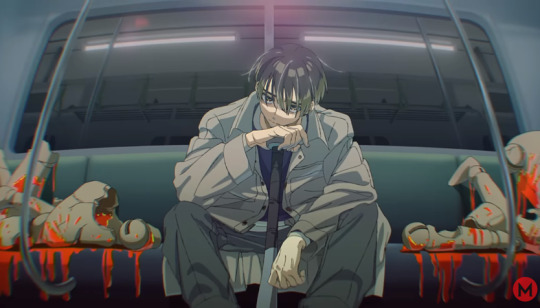
2- The mannequin standing in for Death in the Death card is blue, a color most associated with Mikoto.
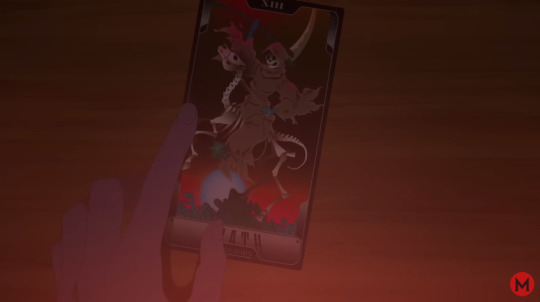
This one isn't great because you can read it more symbolically, with Mikoto being the main force of change in the system's life instead of someone who brings death. Though I'd argue the mace thing sort of implies something more violent.
3- At the start of Double, we see this:
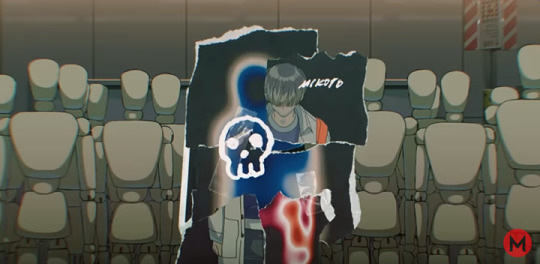

The guy is shown as a blue and red mannequin, but what's interesting is that the blue part has a skull and the red part has a map thing. I don't consider this very important, but the blue with the skull could be indication of Mikoto having killed someone.
4- In Double, Mikoto is represented by antlers (I think that's what they are) in the same way John is represented by a crown of thorns ("savior", etc).
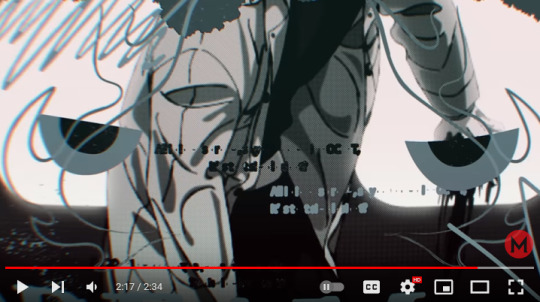
Antlers mainly represent strength, which feels a bit weird for Mikoto. I'm gonna be honest, I'm not confident on what these represent. But one possible interpretation comes from the fact they are always paired with the lyric (written on screen) "All I did was dream, so you find me INNOCENT, it’s that simple right?". The connection of the antlers with Mikoto's dream could imply Mikoto tried to use strength to fulfill a dream, which could imply he murdered someone to achieve something. Additionally...
*sigh* Antlers fall off after mating season, which could be connected to Mikoto "losing his antlers" after John is born, since Mikoto doesn't have to kill anymore.
I'm sure there are other interpretations, but I don't think this one is too bad.
------------------------------------------------------------------------------
So, all of this, is it conclusive evidence of anything? I wouldn't say so, it's all still pretty vague. However, I believe all of it together points to Mikoto having killed one person, and this is what explains all this in the best way. Thus, I presume Mikoto did kill someone.
Claim #4: Mikoto's Motivations
CW for this section: potential stalking
I've sorta alluded to it in the tarot section, but I believe Mikoto killed someone in a position of authority over him as a result of workplace abuse. In particular, Mikoto was heavily overworked, possibly to the point this authority figure was somehow monitoring his home life and possibly even stalking him.
Let's start by the workplace abuse thing. This is an extremely important point in Mikoto's narrative; it's referenced in his Undercover silhouette shot, it's shown in the messages from "Chief" at the start of Double, the neuron scene from Double, his interrogation questions, etc. Mikoto is being overworked, to the point his boss/manager/whatever talks to him about work past midnight. It would be very strange, narratively speaking, if all of this didn't have anything to do with the murder. Also the whole "Queen of Swords is the Challenge/problem" could allude to an authority figure, which also fits this idea.
So then, what about the monitoring/stalking? Well, there's a lot of camera imagery in MeMe, for one. Most notably in the scene when Mikoto comes home and leaves his bag to the side as he breaks down, relating his stress to the idea of being watched. There's also an abundance of eye imagery in Double, especially in relation to Mikoto. This is also included in the MVs version of the Hanged Man card, which has a bunch of eyes around the mannequin. This alludes to some form of judgement or pressure, (<- Fuuta reference?) which could be connected to either societal pressure or, what I find a bit more likely, the judgement of Mikoto's higher-up(s) in his workplace.
Because of this, I believe one of Mikoto's higher-ups was heavily monitoring Mikoto's life even outside of work, which drove him to the point he felt he had to get rid of them. All he did was dream... of a better life.
This could also be why John hides the reasons for the murders. Even if he is actually aware of the full situation, he could be trying to hide that Mikoto felt tired from work, because in a way it's possible Mikoto would consider that shameful. I hope that makes sense.
Claim #5: Which is Mikoto's kill?
Assuming Mikoto only killed one person before John started taking over murder duties-
(I think that's a fair assumption, I think it would be weird if John only split after like three murders. Like, oh the first two weren't stressful enough to cause a split, but the third one is too much? What? There's something else that makes me think John split after just the first one, we'll get there)
-that begs the question: which one was Mikoto's? Well, since Double isn't exactly reliable for what the murders looked like, I'll only take MeMe's versions into account. There are at least three murders in MeMe: the Subway Murder, the Streetside Murder, and the Trash Bag Murder.

We know the Trash Bag Murder is different from the other two because the murderer isn't wearing a hoodie in that one, a fact which took me an embarrassing amount of time to notice. Unless he went home, changed, went back to dispose of evidence and still had the beanie for some reason (since he throws it away), it has to be different. And probably on a different day, too. Because of that, I'll henceforth call it the No Hoodie Murder.
Let's run through what we have. We see the Subway murder almost in full at the beginning of MeMe, where Kayano swings around his bat flippantly before killing a blonde dude with a simple overhead swing. However, right in the middle of that scene, we quickly cut to the Streetside murder, where we see Kayano hitting the victim with a right-handed swing.
After that we have a scene of John (because at this point it would be John) coming home and taking off his shirt. Since there is a Fool card portrait in the background, I'll call this the Fool Portrait scene. Notably, we never see John take off a hoodie or a beanie, meaning this is probably related to the No Hoodie Murder.
Then we have Kayano doing... something to the Streetside victim. It's unclear exactly what that is; I've seen some people say he's burying the victim, but to me that always looked like he's dismembering them to put them in trash bags. It's not too important, though.
An important fact is that in this scene we see his left cheek is blood-stained. This is consistent with the following bath scene, where we see John brushing his teeth with blood trailing down from his left cheek.
In the middle of those scenes, we see the clean-up for the No Hoodie murder. Trash bags and the beanie are disposed of in an illegal dumping ground.
Finally there's the bathtub scene, but frankly it's not very relevant to this discussion.
So, which one is Mikoto's? I'll start by ruling out the No Hoodie murder. There is an argument for it, though. It's definitely the most hidden of the murders, which makes it suspicious. Since the Fool represents new beginnings, you could argue the Fool Portrait scene shows John's "beginning". And since I said it's probably related to this murder, you could argue that means the No Hoodie murder is the first one.
However, that doesn't really convince me. Unless the Kayanos have multiple beanies (which is possible, but I'd find it weird narratively speaking), this would have to be the last murder in the sequence, while Mikoto's would have to be the first. The fact it was done without a hoodie also contradicts the 3rd Anniversary artwork reasoning, since Mikoto wears a hoodie there, but to be fair the lack of beanie makes the outfit somewhat inconsistent anyways.
Meanwhile, you could argue there's a symbolic implication that John and Mikoto have already split by the time the Subway murder happens, in the way the towers close and behind Kayano have lighting split down the middle between red and blue light.
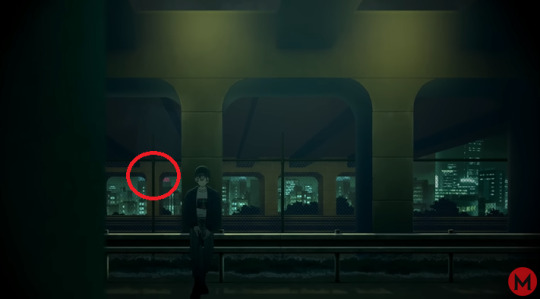
(Yes this is one of the reasons I'm keeping the red and blue color scheme despite no longer believing RGBkoto)
No, I believe the Streetside murder is Mikoto's. It's technically the first one we see, but more importantly, the location matches Mikoto's prisoner card image, and the swing fits the Undercover kill-shot.
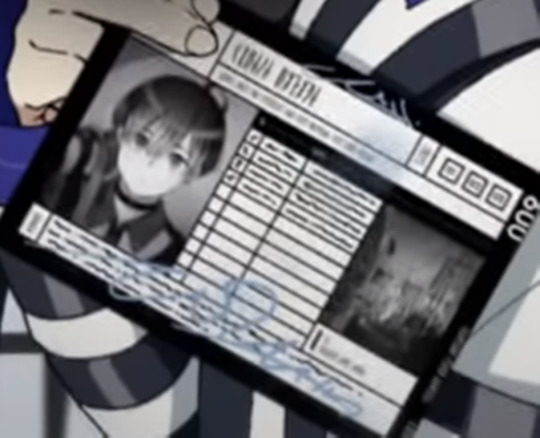

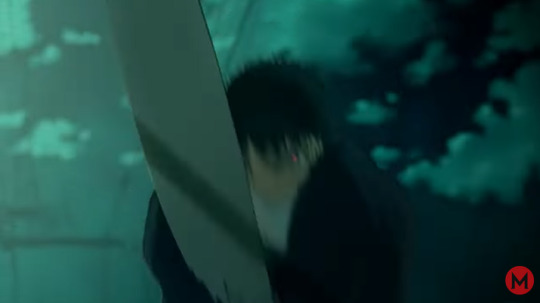
Since Mikoto is the Milgram prisoner, these two things would probably be related to his murder, not Johns'.
Funnily enough, you can also argue that this murder is too expressionless for John. Which sounds odd, considering John is usually the less expressive of the two, but funnily enough, the only times we see John express emotion is when he goes to do a violence, either because he's frustrated at the person who hurt Mikoto or because he's happy to protect him.
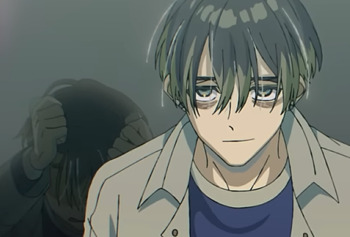
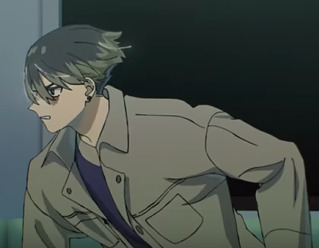
[John Doe]
John: SHUT YOUR MOUTH!!!
Es: *Gasp*
John: YOU KEEP BLABBERING ON AND ON...
I'M GONNA FUCKING KILL YOU, YOU PIECE OF SHIT!
*John continues to beat Es*
John: GOING ON, AND ON, AND ON...
ALL HIGH AND MIGHTY... LIKE YOU AREN'T JUST A KID!
SERVES YOU FUCKING RIGHT!
Es: …emember…
John: HUH-!? I CAN'T HEAR YOU!
YOU'RE NO MORE THAN JUST A KID. YOU UNIMPORTANT BRAT!
Es: .........I'll remember you… you murderer…!
John: HUH?! *Laughter*
YOU PREFER IT WHEN IT HURTS MORE, HUH?
Es: ......!
John: THAT'S FINE... I'LL CRUSH YOUR FUCKING FACE.
Es: Go ahead… and try…
John: YOU DON'T NEED TO TELL ME TWICE! *Screams*
[...]
Kotoko: His technique is definitely that of an amateur…
John: SHUDDUP!!!
Kotoko: ...! *Sighs* I can't imagine that power from his muscle mass.
John: ANNOYING... YOU'RE ANNOYING...! ARGH...!
This even fits the lackadaisical twirling of the bat in the Subway murder. It's one of the reasons I believe that one's John's.
Meanwhile, the one time we see a Kayano swing a bat without emotion on his face is the right-hand swing in Double, which as we established is probably Mikoto. Thus, the idea that John shows more expression than Mikoto when it comes to murdering holds up. The punch at the end of MeMe doesn't count because that's John attacking Mikoto, which is only metaphorical.
Still, this isn't exactly great evidence of anything, since John is still usually less expressive than Mikoto in general.
Anyways, which murder is Mikoto's isn't too important anyways, this section was more to satisfy curiosity than anything else.
------------------------------------------------------------------------------
And that's it! Again, this is just my interpretation and theories, it's perfectly fine if you believe something else. I know it isn't anything new, but I wanted to put it all in one place so I can reference back to it if, say, I'm answering an ask about whether or not I forgive the prisoners' murders (I swear I'm working on it lol). Anyways, take care!
95 notes
·
View notes
Text

“This is a warning for Kray Foresight - free all captive Burnish immediately, or I’ll burn Promepolis to the ground!”
Many hours, layers, micromanaged bg assets, and egregious amounts of colorpicking later, it is finally done //passes out
As soon as I watched Promare I was legally obligated to draw the dragon.
Please do not reupload without permission!
(Very ramble-y) process notes and wips below the cut:
[[Shoutout to Tamberella’s wonderful city brushset, the bg would not have been possible otherwise!]]
I had to cross-reference so many stills and gifs from the movie in order to try and recreate the atmosphere and style XD This whole drawing was also the perfect excuse to whip out the polyline tool again, it’s one of my favorite things to draw with but I don’t actually use it much for...some reason lmao. Habit? Who knows...
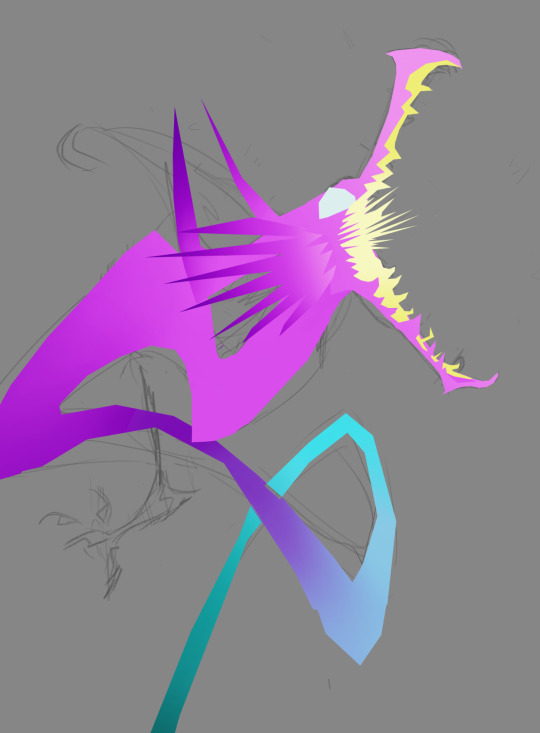
As you can see, it was initially supposed to include his lil arms, but I couldn’t find a way to make them flow well with his line of action and had to exclude them (which was a bit painful as I was really happy with how the claw shapes turned out). I figured since the film seems to cheat it the same way, it was fine for me to do it as well XD Though I don’t have a capture of it, originally his body was also in a more straightforward loop-de-loop kind of shape.
I wanted to put special focus into the pose and sense of action (two things Trigger really excels at), namely when it came to the head and jaws. I noticed that in a couple of shots the dragon’s jaw is “broken” - opened at an unrealistically wide angle - to better emphasize the action, and while I didn’t take it as far as Trigger did I wanted to try and capture something similar in my own way.


The windows required SO much micromanaging. I blocked out a “template” of windows using one of the brushes in the mentioned set, grid-warped it to align with the perspective, and then copy-pasted it onto each building and then manually went through each one to make sure every patterns of “lit” windows was unique and felt believable. The process had to be repeated twice, for both visible sides of the buildings. As far as individual parts of the pic go, that step probably took the longest.
I also really wanted to somehow incorporate triangles into the drawing since they’re so representative of the Burnish and the Promare, and adding some around the face seemed the most intuitive way to do it.

A lot of miscellaneous things were added at this point, such as the ground flares (polyline tool my beloved), the smoke, and smaller details like making sure the dragon felt more “sourced” in the scene by clipping the tail behind a tower. The background was also blurred, to help sell the perspective as well as keep the focus on Lio. The flares were one of the hardest things to manage in the latter regard, too, as due to some oversights in my initial color choices they were actually brighter than Lio and stole his thunder! So it took several different tries to find a way to successfully de-emphasize them without inadvertently making them some weird sickly color XD
If you read through all of these notes, thank you so much, I love you!! //hands you a cookie
Bonus layer screenshot:

#reupload#personal fav#promare#if you were one of the people who reblogged or liked the original THANK YOU!!#it meant so much to me you have no idea!#and if you ARE seeing this again in the tags please pardon the dust of reuploading it here too XD#I just still like this one a lot so I wanted to bring it to my new art blog as well#everything in one place and all :P
111 notes
·
View notes
Text
the Onikakushi Usoda scene is so interesting bc it has keiichi insisting that this is Out Of Character for rena, that this isn't the rena he's always known, that this isn't his rena - even though he's only known her for a few weeks - bc she did something that broke his image of her as the Ideal Cute Girl. he never brings into question who he is as a person to the reader, and keiichi here is the audience's surrogate. he never looks within himself or considers the unreliability of his perspective of the events surrounding him. this is very meaningful. you, as the reader, think nothing of how this boy was just screaming at his friend, how he'd grabbed her, and how he was hurting her while demanding she tells him everything he feels he's entitled to know, despite hiding things himself. the moment rena gets angry and snaps back at him though, that's actually a reason to be scared, a reason to feel as though something is inherently wrong. after all it's wrong for girls to present themselves as anything but available and nice at all times. anything else makes them ‘abnormal’. ‘hysterical’, even.
we focus entirely on the horror of rena's seemingly sudden change, so the harm keiichi is causing becomes a literal afterthought the same way it’s one for him, even though that’s the real horror of the situation. he's an unreliable narrator, and an example of how the narration can lie to you while criticizing you for taking it at face value. keiichi is SO self-centered in this arc that even when he learns that satoshi is a houjou, and is satoko's brother - he never stops to consider what this means for satoko or the club as a whole who actually knew him, it's all about Him and His Problems (HE’S LITERALLY DEAD FOR ALL THEY KNOW OF COURSE THEY’RE GOING TO AVOID TALKING ABOUT HIM ESPECIALLY WHEN IT MIGHT BE TRIGGERING FOR SATOKO IN PARTICULAR). keiichi’s viewpoint first and foremost is that he's THE victim. that’s the most important thing to him throughout this arc. even when mion tells him to drop the 'satoshi' act bc it's actively hurtful for those around him who are still grieving satoshi’s loss, all he does is hurt her the same way he’s been hurting rena.
we also have ooishi (mfw you dig into a girl's background and medical history with mental illness then talk about it to her classmate without her consent bc you want to use him as bait for your investigation!!!!!! THERE’S A REASON THE ONLY TWO ARCS WHERE OOISHI DOESN’T SUCK HARD AS A PERSON ARE MINAGOROSHI AND MATSURIBAYASHI WHERE HE FINALLY STOPS ACTING LIKE SUCH A FUCKING COP (HIGURASHI SAYS ACAB BTW REAL AND TRUE)) telling keiichi about rena, and even when it’s BLATANTLY clear that the three male friends hurt rena in some way and they are ashamed of their actions which is why they seemingly took a deal to not press charges together with the school so as to not have charges pressed against them, we have keiichi doubling down instead of stopping to consider that, maybe, she didn’t “undergo a sudden change” and attacked them before breaking all of the windows in the school for no reason whatsoever. maybe they did something to trigger her. he never stops to consider that, maybe, rena is actually a victim in the situation. “rena has a disorder that normal people don’t” is a funny line when taken out of context, but it’s just keiichi continuing to frame rena as Abnormal, Cursed, and Weird for being mentally ill. it’s especially clear in the door slamming scene, where it’s just rena trying to pacify a clearly stressed out keiichi with some light teasings, only for everything to backfire and for keiichi to react so violently...but, still, rena continues to stand outside, apologizing. she feels so bad. no matter how ‘monstrous’ keiichi’s actions become, she’ll continue to be there for him bc she understands.
the fact that tsumihoroboshi reveals that keiichi shot a little girl and he also damaged her eye the same way rena permanently damaged one of the boys’ eyes is literally the narrative chiding YOU AND KEIICHI for ever judging rena for the same crime he committed, and the reason they never elaborate on why rena did this is bc it literally doesn’t matter! you and keiichi aren’t owed rena’s background and the things she wishes to keep a secret to justify to yourself not treating her like a monster! not treating someone like a monster for their past and struggles with mental illness is just basic decency, they don’t owe you the details or justifications. tsumihoroboshi keiichi agonizing over the girls not knowing his admittedly terrible past and them being like "we don't need to know literally everything about you, man, if you want to keep this shit a secret, it's okay" is very important bc it’s fine to draw boundaries and it’s okay to keep secrets, you don’t need to tell everything about yourself and have others do the same thing back to consider them friends!!! secrets are important in friendship!!!!!!
this is also a good example of how you can make ANYTHING seem scary when it’s taken out of context. you can misinterpret anything you want when you’re missing critical information. you can ignore everything about a person you know and all the obvious clues that point towards the opposite conclusion if you want to demonize them and victimize yourself. if you want you will believe you’re right. that’s what keiichi keeps doing this arc every time he’s told something vague about rena by ooishi.
onikakushi after tsumihoroboshi’s recontextualization becomes a horror story told from the perspective of the actual ‘monster’, arguing its own justification and validating itself for hurting others while framing them as the monsters. the ones with the reason to be afraid and run away in this arc are always rena and mion, but they don't, not at any point - rather, they keep trying to reach out to him, bc while keiichi insists on seeing them as monsters, they never see him as one regardless of his actions, and keiichi isn’t a monster either bc despite the fact that his actions are fueled by his self centeredness and ego, it's also his shelterdness and own trauma and he’s still a victim struggling with psychosis. he deserves to be forgiven despite everything. there’s a reason onikakushi’s poem is the one about forgiveness, THIS IS WHAT RENA IS TRYING TO TELL KEIICHI.
onikakushi is also really tragic from rena’s perspective especially with how higurashi is painfully aware of the reality wherein girls have to present themselves as nice all the time, they need to be this ideal to be palatable (rena’s whole Cute Schoolgirl thing is an act born from her internalized misogyny basically), and yet even when they do, they’re still susceptible to be subjected to violence based on the assumptions of boys and men. this is something that has been haunting rena for her entire life.
she came back to hinamizawa, regretting her parents’ divorce and hurting others, promising she'll never hurt anyone again, and promising she'll always be nice, no matter what happens to her, then keiichi comes along and everything seems fine, they’re friends and he’s kind even though he’s a little mean sometimes, but despite the kindness he showed initially, he still ended up screaming at her, grabbing her, getting mad at her for reasons she can't understand. that’s what her father did. maybe the boys in her school too.
rena is also being affected negatively by everything happening since the festival. she’s manic, she’s scared of falling victim to the curse bc she’s always felt like she’s being punished by oyashiro-sama for ‘sinning’ (leaving hinamizawa), and she has her own struggles with mental illness, but despite all of this she’s still trying so hard to be good, trying so hard to reach out to keiichi and she even explicitly says this at multiple points - that she doesn’t want the same thing that happened to satoshi to happen to him, and she feels so guilty for not being able to do anything a year ago when satoshi disappeared, bc she knows what it’s like to struggle with these things and how horrifying of an experience that is, but keiichi just refuses to let her help - yet rena continues trying, even as keiichi is bludgeoning her with the metal bat, she’s trying, she always will, bc she wants to grant him the thing she wasn’t given while struggling with the same things. she knows how scary it is and she doesn’t want anyone to feel that scariness. if nobody is going to forgive keiichi SHE WILL, but keiichi needs to forgive her too for things to begin changing. rena. rena. rena. i love you rena...
the whole point is that rena isn't some kind of monster who's going to indiscriminately attack others bc she's ~oh so crazy~ beneath the cute girl mask (tsumihoroboshi makes this blatantly clear with how rena only kills rina and teppei bc she feels like she’s been backed into a corner) and keiichi needs to stop being ableist (keiichi himself is pretty sympathetic despite this ofc, bc you understand from being in his head how he arrived at all of these conclusions). after all higurashi is about how mental illness is pathologized and demonized especially in women.
keiichi is constantly torn between two assumptions in this arc: 1) that his friends and rena especially are evil people who have been lying to him all this time or 2) that they��re being possessed by oyashiro-sama to do these things bc the curse exists, but isn’t the core of both of these assumptions pretty ableist? you shouldn’t vilify people for being mentally ill in such a way and you shouldn’t blame their actions on things such as Being Possessed and Being Cursed.
watanagashi also follows up with shion who’s very much a girl attacking and hurting others, bc of how she's been hurt all her life to show that ignoring the person she is makes everything worse for her even if it doesn’t justify what she’s doing. after all keiichi is content to blame what she’s doing on the ‘demon inside her’ instead of trying to see her for who she is. his thoughtless actions and words in this arc lead to much hurt for mion and shion. tatarigoroshi is him selfishly killing teppei in a such a way that he’s robbing satoko of any agency or say in her abuse without considering how this could impact her. his actions leave her even MORE traumatized, blaming herself for how everything turned out for the worst.
when you think of the syndrome as an allegory, keiichi breaking through the syndrome with the help of memory leaks isn't just him overcoming his paranoia, but also him learning to look beyond himself and see how others could be hurt by his actions and words etc etc, which is why tsumihoroboshi is about him atoning for how he hurt everyone and helping rena in much of the same way she was trying to help him in onikakushi. it’s him finally returning the favor. tsumihoroboshi is higurashi’s turning point, bc keiichi finally stops being such a casual misogynist, he stops demonizing rena and tries to understand her, he starts to realize that his struggles and experiences aren’t inherently more valid than the girls’ in his life, and he starts to listening to them more...
#sorry this is probably an incoherent mess but i've been rereading the series and going insane again#higurashi#gamo.txt
143 notes
·
View notes
Text
Lighting and Mike and Will - Full Analysis (Pt.16)
Alright so, this is the last one this is going to be split into. This is going to be the painting explanation and everything after that.
S4:E8 - No, You’re My Heart (#3) / Two Hearts One Monologue
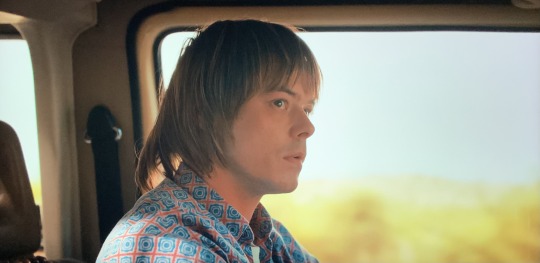
This shot of Jonathan is important because another perspective is being established in this scene. This is a POV shot, because Jonathan is looking in a direction (the mirror) and then we see through his eyes.
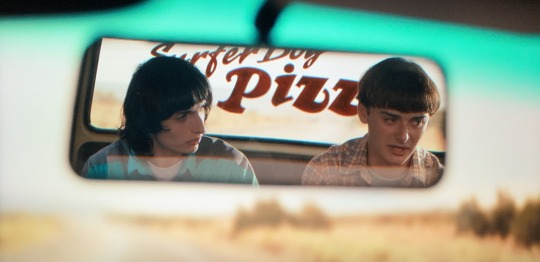
We see that in this perspective, both Mike and Will have light touching their faces. The Logo on the back window also isn’t placed in a way where we can clearly read ‘boy’ in the middle of Mike and Will’s heads.
We can also see that the way this is framed, the background is blue and yellow behind the mirror.
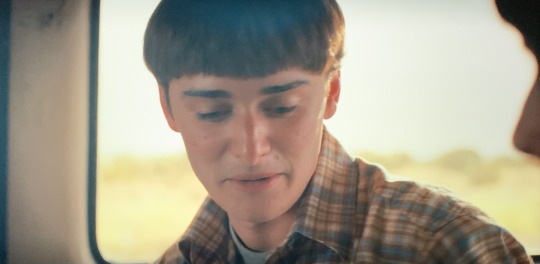
As Will continues to speak in this scene, explaining the meaning of the painting and going further in depth into his own feelings, the light returns.

And the heart gets brighter and brighter in his eye.
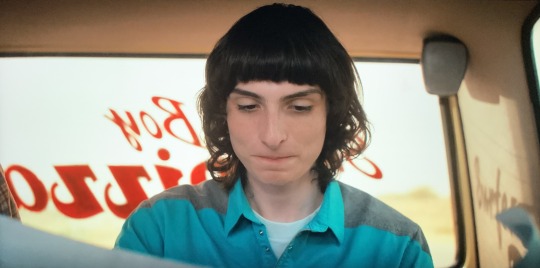
Will’s shoulder is in this shot, and the shadow of ‘boy’ that’s usually on Mike’s side, is replaced by ‘surfer’. But the logo is still there and pointing to Will. As Will explains the painting Mike seems almost happy. As it’s been established within the series already that Mike appreciates Will’s artwork, this is a reaction that makes sense.
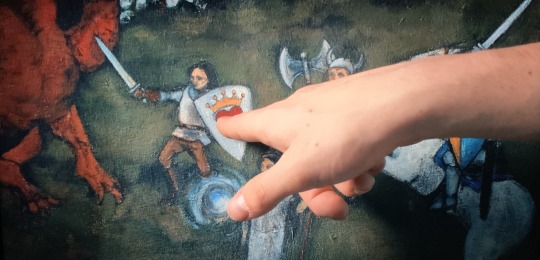
And Will’s hand is pretty well lit when he starts pointing things out on the painting.

The light on Mike’s face in these shots is pretty interesting to me. We’re looking at Will from Mike’s perspective, so it’s a weird choice to have him illuminated.
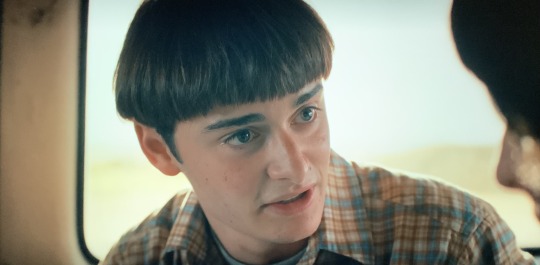
Mike’s perspective of Will here also shows us how careful they are to include the reflection of the van window in Will’s eye.
There are a lot of elements that are going into Mike’s perspective of Will: The lighting contrast; Will being in a softer almost whimsical lighting, and Mike being lit normally, the car window always present in Will’s eye, the way the light is allowed to fall on each of their faces- or rather how it isn’t in Mike’s case, and everything else in this scene and the lead up to it. Symbolism, imagery, acting choices, cinematography, everything is so delicate that it’s hard to see if you aren’t looking for it- unless you either really like film and/or relate to these experiences. (and then you end up in the byler tag on tumblr-)

OTS shot from Will here, so we’re looking at Mike though his eyes. The patch of light on Mike’s face is gone from this shot, so I get the feeling that it might not’ve been intentional? But maybe it was more the angle that it was shot at made it hard to keep the light off of Mike’s face.

Either way, we can see that the light in Mike’s eyes are changing. This could just be the way that the lighting falls, but knowing that this scene took a long time to film and that it had a lot of elements, this light should've had some movement to it. The fact that it’s in the same place and that it shows similar contrast to Will’s heart in his eye, I’d be hard pressed to say there wasn’t something worth looking into here.
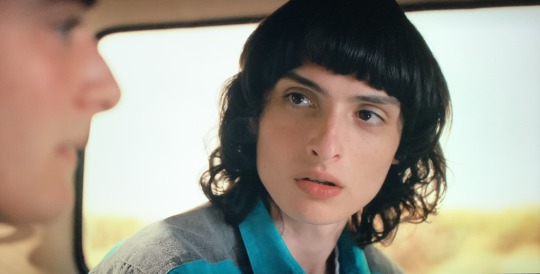
The way that Will’s face is positioned during this shot is also interesting. We’re getting and OTS shot, but we’re also still getting his side profile in frame. We can see his expressions pretty clearly, in a way we usually can’t in Mike’s OTS shots in this scene. I think that we’re making our way to the same level of shared narration that Mike and El’s fight had.

Looking closer into Mike’s eye here as well, we can see that the light has gotten brighter. It’s moved slightly, but still maintains it’s general shape; an downwards pointing obtuse angle. In Mike’s other eye, it’s not as obvious, but we can see coming from the singular point of light, a sort of weird bend to the lights there. This could just be the angle of the light and refraction of it on Mike’s eye, but we can also see it in his other eye (the one with the brighter light) as well.
There are three main points of light in Mike’s eyes: the brightest one, the dot next to the brightest point, and the signal dot in the other eye.
The two dots have been present since Mike opened the painting. The larger point of light has been subtly growing there since then.
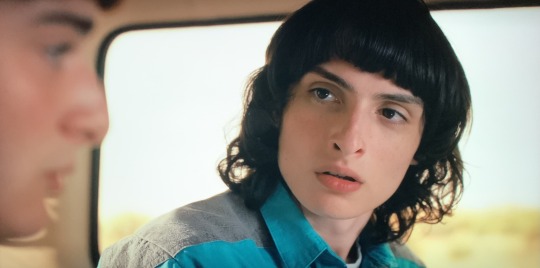
The light is dimmer here, but is still present. And we can still see Will’s face on an angle as he talks. This is a shot that we don’t have many of this season, Mike openly looking at Will as he talks. We can really see what Mike is thinking here from his expressions.
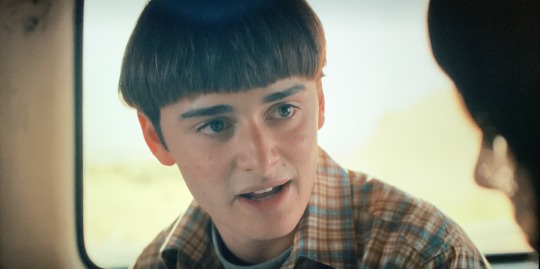
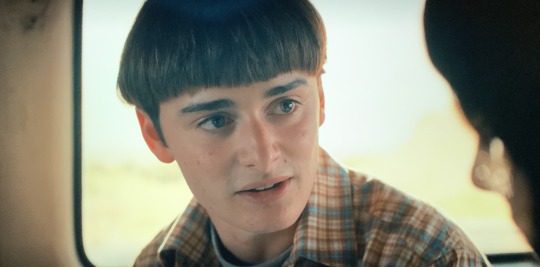


These four frames here are mostly to show that the window reflection is consistent, but as of right here the heart is gone. We can also still see the light on Mike’s face. Will is still in that angelic/whimsical light. The bullet holes in the van next to Will’s head also kind of make a half heart shape, just a little bit.

Jumping forwards a little bit, we get to Jonathan’s perspective. This is a POV shot again, and we go back into his eyes and look into the mirror.
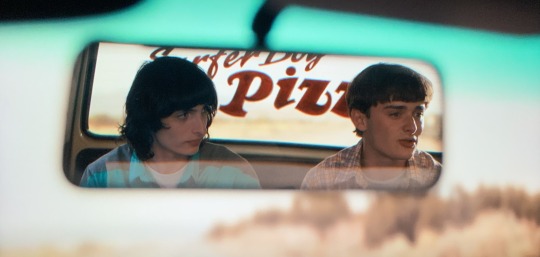
Jonathan is a more neutral perspective than Mike and Will are in this scene, but that doesn’t mean he can’t influence what we take from this scene. He’s Will’s older brother, so he’s naturally biased towards Will. He’s also seen how Mike was at the airport and how Will has been affected by Mike and Will’s communication problems. Jonathan has mostly been seeing Will and Will’s side of things.
Even here we can see that even though the light is far more neutral, Will is still in the light. He’s our outside narration of the scene, but he’s still a character with his own thoughts and feelings about it.

This is the second time we get a mirror view of Mike and Will. Now while this is just Jonathan’s perspective, this could also have meaning in way of the overall scene.
Mirrors are common symbols of literally saying that something is reflecting or mirroring something. Mike and Will commonly mirror each other with their placement in scenes (even just when they were across from each other burying the body, but more so in their expressions, body language and reactions to situations, like when they look to each other for assurance), and in what they’re wearing- They’ve had matching watches for quite a while.
This could be giving us incite into what is happening in the scene. Mike and Will are talking under the guise of El, but this could be saying that they are both using El in place of something else. The reflections of light in each others eyes, and the shadow of the van logo (boy), seem to be in line with the idea of Mike and Will reflecting each other.
“Sometimes when you’re different, you feel like a mistake,” is an interesting line to place here. Mike and Will are being shot very similarly. This line could very well apply to both of them, which would fit with the two of them mirroring each other.

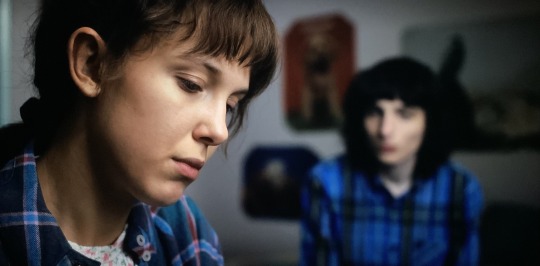
This shot right here parallels Mike and El’s fight really well. Mike is blurred and we can tell that we’re in El/Will’s perspective because of the lighting difference and the way they are positioned in the shot. Mike and El’s faces are in the light in their shot, but neither Mike or Will are in the light in this one. It does flicker over Will’s face a few times but not to the level that he’s lit in Mike’s perspective.
In these scenes, El and Will are contradicting each other. Will is saying a lot of things that oppose what El said. “You make her feel like she’s not a mistake at all” vs. “you think I’m a monster”. We already know that Will was talking about himself here, but this only furthers that.
Mike is also in a very different position here. He’s mirroring Will, he’s not tense, he’s not arguing. He’s just listening.
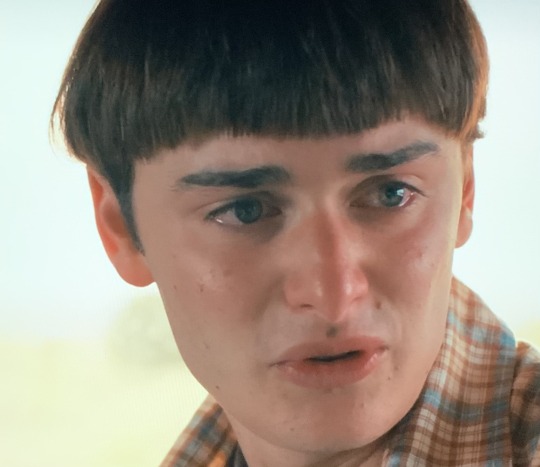
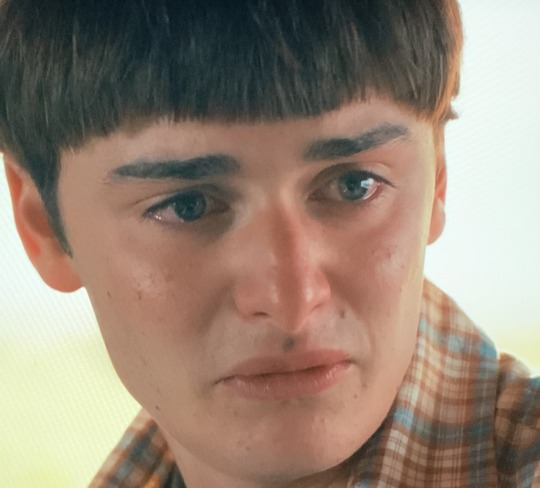
Another occurrence of the heart flickering in and out of Will’s eye when he turns back and faces Mike.
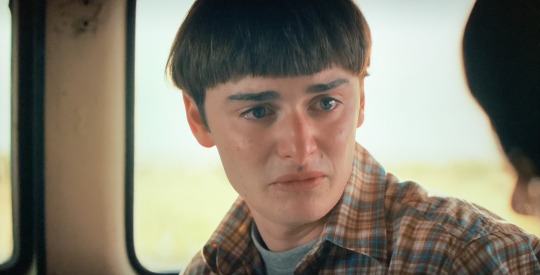
The light progression in this part of the scene is sudden.
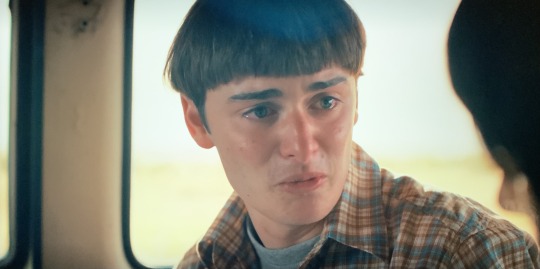
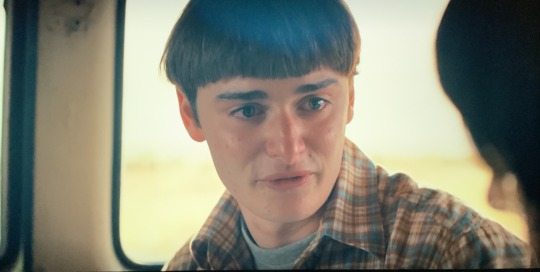
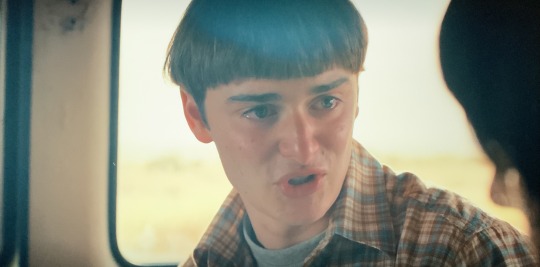
We’ve got an OTS shot from Mike, and the light, so we know that this is Mike.
“You make her feel like she’s not a mistake at all, like she’s better for being different.”
Will gets brighter and brighter.
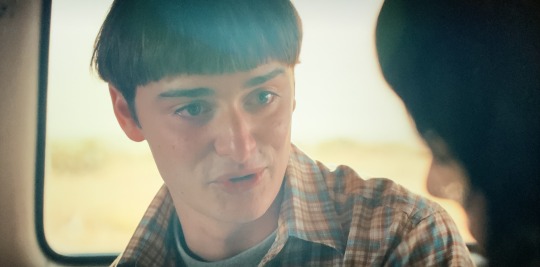

(heart eye number- I don’t even know anymore. I even cut the number I actually put in this post because there are just too many)
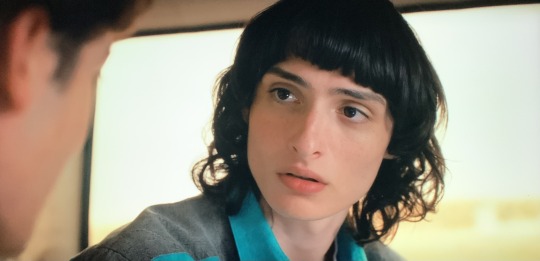
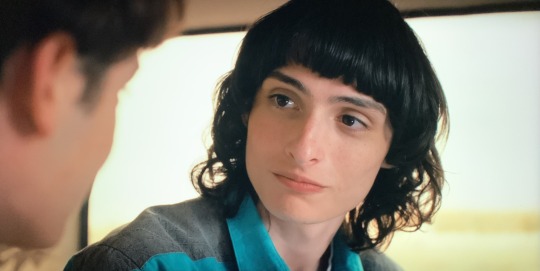

Will isn’t the only one getting brighter. Although it’s way more subtle, the light in Mike’s eye is shining.
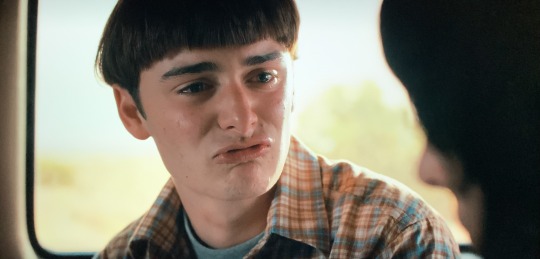
And we switch here from being absolutely blinding, to the sunlight shining brighter on Will’s face and shoulder.

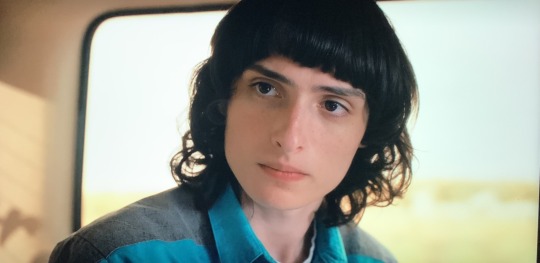
Mike’s expression during this part of the scene consists of a few occurrences where he breathes in a purses his lips. I find it really similar to when you try to stop yourself from crying before you even start.

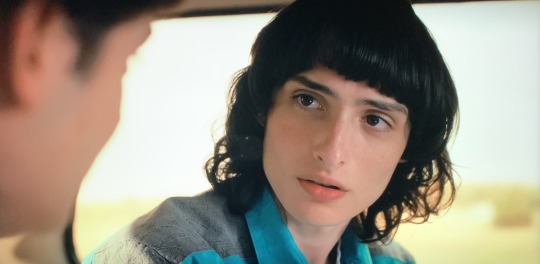
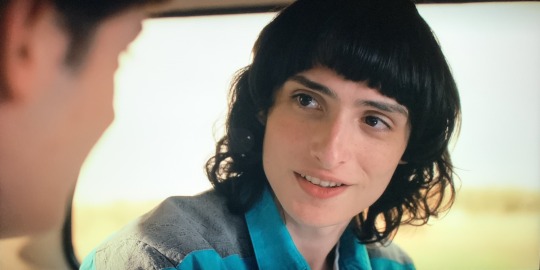
The light in Mike’s eyes flares up when he says, “yeah?”. That alongside the fact that the lighting was consistent for that long, makes me think that it does mean something.
But also, Mike isn’t relieved here, or happy. He almost looks hurt. He looks away from Will for a second before he starts talking. His eyebrows are slightly furrowed and while he does look very softly at Will, he kinda looks like he might start crying in some of these frames.
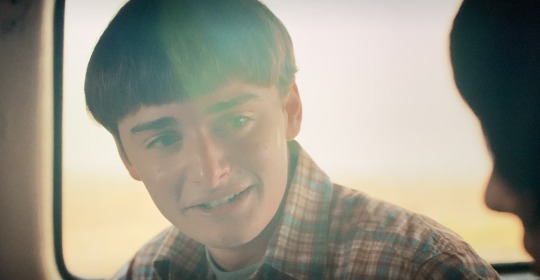
And then we go back to Will, and the yellow and blue lights have returned and the angelic/glowy/whimsical lighting and he’s looking at Mike the same way that Mike is looking at him.
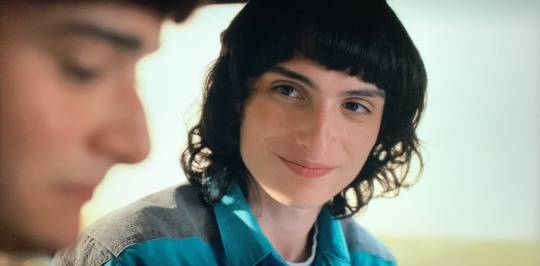
Mike is smiling at Will. Smile lines on his face and his eyebrows unfurrowed. We’re also looking the side of Will’s face. This may or may not be from Will’s perspective. But I don’t think that it is. Because, the lights in Mike’s eyes have faded almost entirely. Mike is looking at Will here and we get to see it.
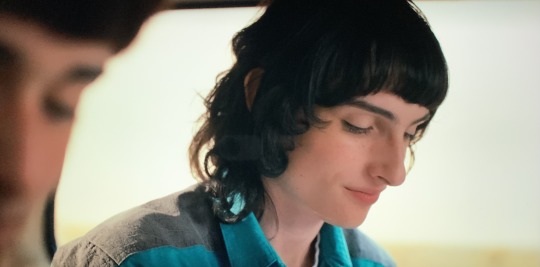
But we also get to see the smile drop as soon as Will turns away.
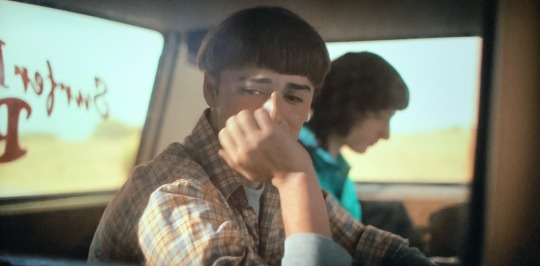


Will turns away and starts crying, but we can still see Mike behind him. He’s out of focus- Will being our center of attention- but we see him tun to look at Will briefly.
We see Mike looking at Will.
Mike has been looking at Will nearly all of this season, but we don’t see it because we see what Mike sees; we see Will.
But this isn’t Mike. And this isn’t Will, because why would we see Mike looking at Will if Will was the one narrating?

Then we get this. Jonathan looking up at the mirror we know is there.
But we don’t get another mirror shot.
And sure, it’s already been established that Jonathan is looking at Mike and Wil through the mirror, but those shots also gave us an important outside narration of the scene.
If Mike took all of what Will said at face value, as just about El, and he noticed Will crying, there would be no reason not to at least pat him on the shoulder or something. Mike isn’t cruel. And we’ve seen that even when he’s an asshole, it’s never towards Will, not without immediate regret.
If Mike was thinking about El during this conversation, he wouldn’t look at Will like he’s the sun. He wouldn’t look at Will like he’s in love with him. He would have looked relieved by the comfort, not like he breaking in half and falling in love at the same time.
Mike asked Will, “What if after all this is over, she doesn’t need me anymore?”
And Will told him, with his entire heart, that El would always need him. He tore himself to pieces to comfort Mike. But I think Will got it wrong. Maybe Mike was asking or Will to tell him that it would be okay if El didn’t need him anymore.
After Mike’s smile drops, we don’t get to see what happens next. We see Will crying, and we see that Jonathan sees that, but we don’t get to see Mike.
We aren’t done with this scene. The painting still needs to be discussed because Will did lie about it. But also, we never get that third mirror shot.
Jonathan doesn’t give us Mike. We can see that his expression changes but we don’t get any explanation. Only Jonathan knows.
If they wanted to show Mike’s indifference and Jonathan’s reaction to Will, then we would’ve seen it through the mirror. Or we would’ve gotten a front view shot of the two of them. But we don’t get anything.
This seems like something that we’re going to come back to later. But it would make far more sense for Mike not to comfort or even notice Will crying because he was trying not to.
1 2 3 4 5 6 7 8 9 10 11 12 13 14 15 16 17 18 19 20 (to be edited)
#byler#mike wheeler#will byers#stranger things#byler theory#the lights#third mirror shot flashback being plot relevant#im putting this here now just in case#but also i would like to see it#like now
192 notes
·
View notes
Text
My toxic trait is that I will get really into a piece of media and then immediately start imagining the anime for it.
It's quite silly and something that I should really stop doing.
Okay so the Paranatural opening begins with a flash of psychic light revealing an image very similar to the chapter covers of the comic; a circle split in half, the upper half being a classroom from Mayview Middle School, split into five parts (four at the front, one in the middle of them all), with the lower part being taken up by Spender's shadow spirit. The four parts in the front contain each member of the AC and the middle one contains Spender, all five silently posing. Each individual part of the classroom is also taking on the form of each of it's inhabitants world when they are in Spirit Trance.
Much like the zoatrope at the start of MP100 s2's OP, the image comes alive, each member of the Activity Club performing an a small animation (Max uses his bat's magnetic powers to pull his scooter out of his backpack, Ed draws a small X in the air, Spender creates a light flash in the air etc.). Meanwhile in the background notable items from the series start flying out of the image in different directions (the bus that Max jumped through, the Golden Switch from Hitball, the Soup can Max threw. Lefty. Just Lefty).
The camera flies past Spender through the classroom door, bringing us to a wide profile shot showing Max walking to school, as one by one each member of the AC joins him. As each member joins, an animated version of their image from the Cast page appears in the sky, along with items from the first shot related to them (Max has the bus and his scooter, Isabel has Eightfold and her grandpas Spectral Dolphin Blast, Ed has his mom's dream form and Starchman's skateboard, Isaac has Doorman's face and his drawing from that one Supernormal strip)
Just as our heroes are about to reach the school, the Ghost Train flies past, taking up the entire screen and transitioning us to the centerpiece shot of the entire OP. From the night sky above Mayview, the camera begins to fly down into the forest below, with Mina and the agents that joins her, up through Max's bedroom window, showing his family and Lefty (though notably not PJ nor Max)
The camera flies out onto the street outside, where it has suddenly become daytime, traveling onwards past the Jang and down the hill together with Isaac, passing by the floating Garcia, into the Slanted Manse and through Doorman into the Guerra house where Isabel and Ed are racing down the stairs. Through a gap in the tall grass outside we now go to the centre of Mayview, past the fortune teller lady's shop, a poster for Dr. Bigfoot and DJ Mothman's show (in the garbage), Day and Zarei out on a platonic galpal session being served drinks by Penny, before an unfamiliar hook flies by the screen, twisting space and taking us to the entrance to Mayview Middle School.
Flying past the School Store, the Journalism Club, Cody, Jeff and Violet all hanging out, we finally reach Max. You see, this entire massive flying through Mayview-sequence has actually been PJ's perspective, as he followed Max through Chapter 5. Anyway, there's an animated recreation of that one panel from Chapter 1 where Max realizes only he's seeing shades, but this time the hallway doesn't just expand, it bursts.
This sends Max flying in a strange black void accompanied by animated versions of the chapter title pages. The camera then shifts to have him flying down large colored circles, each featuring a member of the AC performing an personal walk cycle, like the shot from Kaguya-sama OP 1. The camera then shifts to the side once more; Max is now falling down the Activity Consortium's dream base, which then turns into a little whirl of sand in Boss Leader's hand. Behind her, Sandman's eyes opens out of the darkness, and as BL flies off to stop it the camera pans down to the agents of the Consortium all posing in their suitsies before performing a spectral flash, taking us to the final shot of the OP.
The Paranatural logo flashes by, recreated in the spirit trance world of all spectral's of the series (it's made out of scrap in Max's world, graffiti'd onto a train in Isabels, made out of those letter playblocks in Dmitri's world, old and crumbled in Isaac's etc.) before turning into it's normal state, before being swallowed by Scrapdragon.
Now I could talk for like three more paragraphs with all of the little details I would add, but what I would like to mention most of all is that during the big "flying through Mayview"-part, each character with the ability to see spirit's turns to look directly at the camera, since they can see PJ.
20 notes
·
View notes
Note
13, 14, 16, and 21. Bring on violence
worst blorboficiation
omfg. Nathalie by a long shot. Literal terrorist. Cool motivation, still murder. Retroactively worse considering sentimonster development. People posture "oh adrien deserves a good mom!" and like.. no, nobody needs a mom. But having good adult role models is very helpful. Sabine could easily fill that role- and if they weren't cowards, they could fufil the mirror of "Marinette comes from a family of bakers but is into fashion" with "Adrien comes from a family of fashion designers but is into baking"
that one thing you see in fics all the time
Lila. People use her as a crutch for villainy. She's 14 ffs, not a megacorp bajillionare d20 on max charisma stat.
Person who is reading this? if you're gunna use Lila as a villian, don't. It's not new, it's not interesting, it's not even fun anymore. Use someone with already established bullying tendancies: (Kim, Chloe, Alya) Find someone new, corrupt a current chracter.
If you need Marinette expelled or excommunicated, do something that would actually get her expelled- she accidentally broke something valuable due to her clumsiness. Taking the fall for another classmate? One too many late arrivals. A failing grade due to ladybugging. Was caught tyring to break through a window to get out.
you can't understand why so many people like this thing (characterization, trope, headcanon, etc)
Zoe. She's a result of bad writing and merch sales, has like.. no personality. They should have grabbed an established background character and elevated them. what about weathergirl? or sabrina?
What if Sabrina being given the bee- or even the dog again- gave her a new perspective, and her growing up and getting a spine is what drove Chloe to become friends with Lila?
Zoe feels narratively useless, and the impact of her arrival is negligible. She brings nothing new or interesting to the table.
part of canon you think is overhyped
Chat Blanc. Like I get it- and like much of the show, it's good potential... but he's not that great, interesting, or even well-executed. The plot with bunnix isn't good either.
Honestly, it could have been a good intro to "Kwami powers without humans as a filter is dangerous" via Gabriel forcing Nooroo to make an akuma. That would keep identity intact, overpower Chat's willpower, and be an incredibly devastating event.
Hell, even if they kept him dead silent, it would have been way more interesting and intimidating. I can't take him seriously with his tearful "uwu save meee huuu" and wiping tears away.
22 notes
·
View notes
Text
Case 3 Begins.

There is an angel in St. Matthew’s.
Beasts Without Burden’s Case 3 has officially BEGUN! And with Xiyun still kidnapped, Whit better act fast...
Read it on Tapas // Read it on Webtoons
Click here for image IDs of all available cases!
Image ID for this one under the cut
[IMAGE ID: The left panel takes up a full half of the page with an establishing shot of an enormous, intricate Catholic church of gothic architecture. There are trees seen in the background, as well as Whit’s van parked out in front of the steps, though the reader cannot see Whit yet. The church is built symmetrically, with two looming towers framing the centerpiece of the building. The steps lead to a shaded area with three enormous, heavy wooden doors, each door framed by an arch that someone would have to walk through to reach it.
Above the entrance are two additional, slimmer towers of stained glass. Behind them is the enormous face of the rest of the church and an enormous stained glass window depicting indistinguishable saints.
The right tower is bulkier than the one on the left, with a central chamber near the top being surrounded on at least two sides by enormous round windows of stained glass. There are three crosses at the tops of the three highest points.
While the trees, the van, and the building of the church are in greyscale, the windows of the church itself are a myriad of rainbow color. The colors seem to glow from within the glass.
Two grey text boxes identify this as the Church of St. Matthew, 6:43 P.M.
At the bottom of the left side panel are three free floating stained glass windows in the shape of pointed arches. The first window, rendered with a mildly blue border, shows a profile view of a medium-dark skinned man with loosely coily black curls to the nape of his neck. He is a Puerto Rican man of approximately middle-age, and he wears the vestments of a priest. The man is rendered in black and white and his expression is stern.
In the background, the stained glass is rendered in full-color, albeit in tones of saturated blue. It shows the first scene from the story of Abraham and Isaac- Isaac, kneeling to the right of his father, has his head bowed and his hands obscured by the priest in the foreground. Abraham raises the dagger in his hand over the bowed head of his son, preparing to strike. Both father and son have halos of sharp, geometric lines.
The second stained glass window, rendered with a green border, shows the same man in the foreground, but now his face is obscured. He is in motion and is walking from the panel. In the background, the second part of the story is rendered in warmer tones. An angel appears to Abraham, one hand outstretched and the other raised as a motion to halt. Abraham’s back is turned to the viewer as he gazes up at the angel. The angel has indistinct features but has short blond hair and feathery wings, wearing a perfectly round halo. The priest in the foreground obscures Isaac.
The third stained glass window, its border rendered in maroon, shows that the man has mostly gone. In the background, Abraham holds tightly onto his son as Isaac slowly rises, although his head remains bowed. Abraham looks to where the angel points to the right side of the panel, where a ram colored in pink is depicted. The tones of the glass are now more red than blue, and Isaac is revealed to have been bound with his hands tied together.
In the foreground, the priest’s stole, swaying as he walks, makes a cut across the ram’s throat.
The top right panel shows a perspective shot looking up at the priest’s feet as he ascends the stairs with a clak… and the rainbow colors of stained glass are seen through the bars of the railing. Rainbow light spills from above.
The middle right panel shows a shot of the priest’s hand as it rests on the banister. Rainbow light spills over the back of his hand and he wears a rosary around his wrist. Three of the rosary beads have rainbow colors to them, with the middle bead showing a full rainbow sphere while the two beads on either side show slivers, like marbles, or like eyes in the motion of blinking.
The bottom right panel takes up the majority of the right side of the page and shows a perspective shot of the priest ascending a long, spiral staircase. The greyscale of the stairs is a stark contrast to the rainbow color of the stained glass windows reaching floor to ceiling alongside it, depicting the same story of Abraham and Isaac as was described earlier. There is the gentle clak… clak… of his footsteps in the empty room as he ascends toward the higher floor and the enormous circular stained glass windows there.
The background behind the panels begins as the normal white void, but it soon becomes a gradient of grey. END ID.]
#tapas webcomic#tapas comic#webtoon#webcomic#webtoon comic#bwbcomic#supernatural#original fiction#black and white#terra's work on these pages in particular were gorgeous and i'm goin insane as we speak
20 notes
·
View notes
Text
KEEPER - Lens Tests and Personal Development
Through the early part of this term, I have been trying to get to grips with the new equipment available in my fourth year, develop my overall understanding of cinematography and attempt to find more work in the camera/lighting departments.
During the summer, I spent some time with MTP on set in a work experience/shadowing capacity. This was very interesting, being able to watch a camera and lighting team work on a commercial for a day. I was picking the Gaffer and Cinematographer's brain and observing how the light was being used on this set. One thing I was missing in my lighting knowledge was a bit of clarity on using soft light. In my mind, I had associated the softness of a light with what materials it passed through, instead of the size of the source. I realised I had used the diffusion totally incorrectly on The Play, a short from last year. I was trying to put more layers in front of the light to soften it without widening the beam. For example, I had a light shining through a window which I had skinned with half-white diffusion, but, hadn't allowed the light to fill out the entire window. On Longboard Nights, the last short I shot, I was using primarily hard light which I think matched the mood of the piece, however, I wasn't controlling the bounce correctly. I was wanting high-contrast images and thought hard light would do most of the work for me. However, in a house with white walls, creating high contrast really relies on the minimising of bounce and spill. That set also showed me something I should've used all the way through the shoot of Longboard Nights which was: when trying to shoot night interiors during the day, skinning the windows with blue gels and ND can give a dusky ambience to the room, which can then be accentuated by any planned lighting. While this was a great day that taught me a lot and introduced me to great people, I am kicking myself that I had to turn down a job offer that I got off the back of this, because I was still working hospitality and it was late notice. This is something I'll need to work out the balance of upon graduating: paying the bills while also being available for any career moves.

Wee Alex in the background, on set doing some really impactful interviews for "Don't Say Gay", find the teaser here: https://vimeo.com/885958871
In the first month of term, I spent a few days working as a Grip on two projects - one a documentary, the other a scripted drama short. Again, I was learning a lot about the importance of soft light in an interview setting, but also working with natural light on the drama short, something I have taken into the test shoot for Keeper this term. It was also interesting to see how the cinematographer worked with the director. I really enjoy the way Ben and I work together and I think it opened my eyes to the things we do well (our communication is very clear and the trust is there, I think) and where our methodology for how we tell the story is lacking. This is something we reassessed after the Test Shoot which I will expand on in another post.
Then, with our first few classes this term, I was having a couple refreshers on Lighting, where I could put this developed understanding into practice. We also spent the time learning how to use the Alexa Classic which I then used on the Test Shoot in November.
I have always believed that the cinematography must follow the story instead of having any motivation around beauty or interest. So, the script development phase is the perfect time for me to be developing my overall skills instead of trying to develop the look of the film.
However, once I had a clear idea of what the story involved, I was able to start conversations with Ben about the perspective of the piece. We agreed that the film should be entirely from Will, the protagonist's perspective. In my previous work, the camera's perspective was mainly designed to accentuate emotion - for example, The Play's wide frames and locked off camera accentuated the emotional distance between the characters. But, this approach was an observational one, the audience's emotions are being played as an observer, without a direct association with the psychology of any of the characters. For Keeper, we feel that the only way that the full drama and impact of the story can be felt is if we are with our protagonist throughout, so we can see how much he cares, how hard he works, how his insecurities are brought forward and how hard it hurts when he realises he will never get what he wants. So, as a guiding principle for this film, we will only be seeing Will or what he sees, how he sees it.
With this idea pretty much locked-in, I was able to test the lenses available to me with an eye for how they would impact this idea of perspective. Here are the results (I forgot to export the subtitles which specified the lens but I know, and when we made decisions we knew which we were choosing, just take my word for it). Probably best to watch at 2x speed, it's a bit long...
vimeo

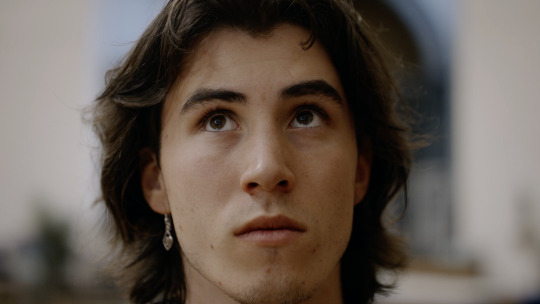

A close-up on a 24mm, 50mm and 85mm
I knew the frame sizes and views we would most likely be relying on: close-ups on Will, wides of the pitch, mids of Graham at a distance. I found during these tests that for the early parts of the film, I would want to be watching Will in a 24mm as it gives a view wide enough for us to see him and his environment without being so short as to be distracting in it's warping and unconventional rendering of a face. But, as the film progresses and Will becomes increasingly insecure and loses sight of anything but his own performance, we move onto the 85mm via the 50mm. This approach also worked for me with the changing room scenes that sit either side of the training session.
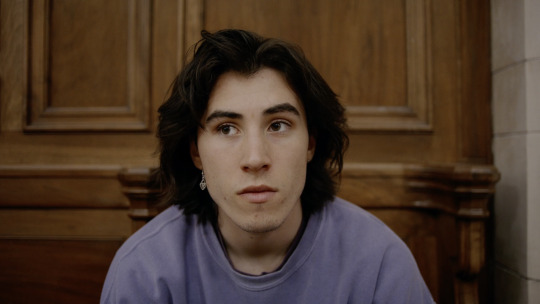
Will sitting in a MCU on a 24mm
In the first changing room scene, we can see some of his team mates' shoulders, his clothes hanging up - we are situated in the space. But then, when he returns, he feels totally alone. This is where we could still go in two directions. One is to come in close, to analyse Will's emotions in this moment and the other is to go wide to feel his isolation and loneliness.
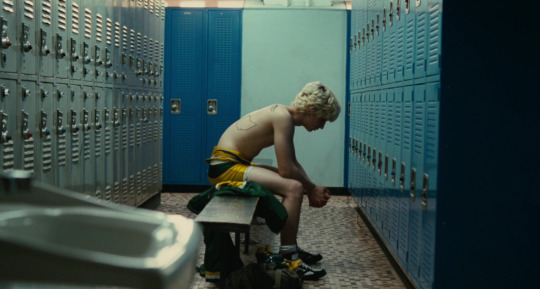
An inspiration still from Win Win (2011)
Another building block of Will's perspective is his watching of Graham, the coach, whose opinion of Will determines his future. I wanted to see Graham in an over the shoulder to better emphasise the perspective and by blocking part of the frame with Will's shoulder, it pushes us in closer to Graham, adding intensity without needing to be tighter in. This I liked most on the 85mm, again, this was due to a balance of environment and subject.
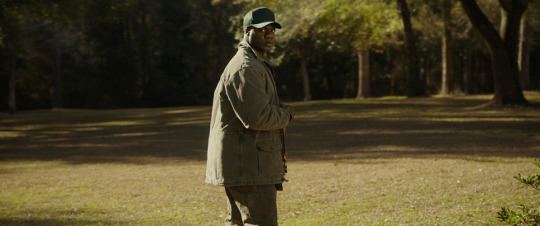
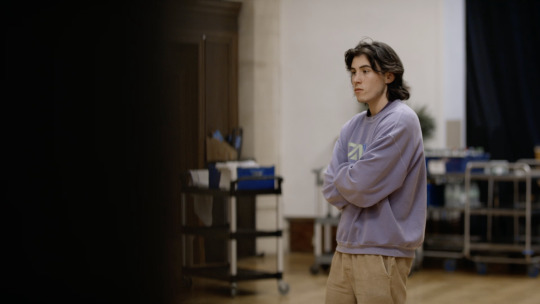
A comparison of Get Out (2017) 's clean single and the dirty single from my tests
Another view I wanted to have was the expanse of the pitch, to see Will looking out at too much for him to handle. I wasn't able to frame up properly during my tests as I had a limited time and I was both operator and stand-in, but I think the 24mm, was again the right choice for this view.

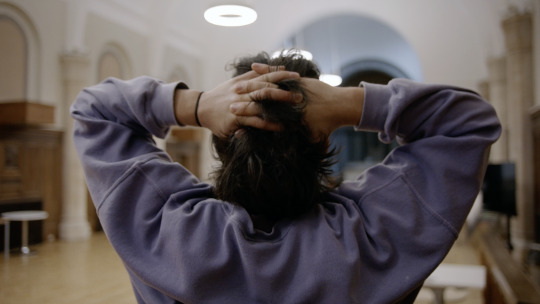
An example of what I wanted to achieve and the result of my test
I edited all the tests together and talked them through with Ben and he agreed with my preferences. Now, we have narrowed our lens choices to the 24mm, the 50mm and the 85mm for the vast majority of the film.
Following on from my previous post where I talked about maybe using a wide shutter angle during the free-kick scene, I also did a test of this at the same time as my lens tests. But, after the test and talking with Ben and Rosie we actually decided to go in the opposite direction and gor for a 90-degree shutter angle for the majority of the film (I took some persuading). We watched the classic example of a 90-degree shutter angle - Saving Private Ryan (1998) - and I found it to not suit our story.
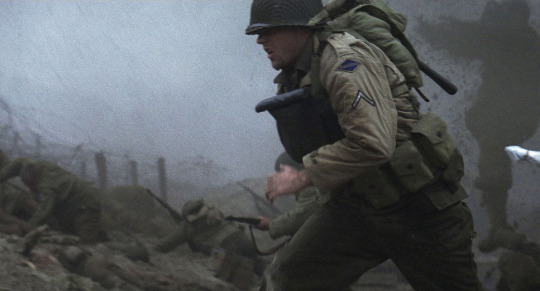
Saving Private Ryan's 90-degree shutter angle sequence
My main issue was the way the shutter angle exacerbated camera shakes, making them stick out far more than at another shutter angle. I felt the film's environment was sterile and controlled, which any camera shake would undermine. However, when Ben and Rosie explained to me how it would better fit Wills emotional state, I came around. Will being hyper-aware and adrenaline fuelled throughout the training session lends itself well to a crisp image, with minimal motion blur, not to mention that audiences are also used to seeing sport shot at higher shutter speeds so it would feel more realistic. On top of this, the idea of sterility and control can be achieved in a multitude of other ways, namely the lighting, production design and lack of handheld camerawork.
Anyways, after these tests, I was in a more informed position to be making some decisions about the look of the film. I had lots of discussions with Ben about the tone which helped me decide on lighting approaches. The realist tone of the film meant that I had to be very motivated with my lighting, making sure it made sense for the world. A lot of the script dictated how I was to light the film which really helped as Ben has such a clear idea of how it needs to feel. One thing that the script specifies is the fact that the session takes place at night, under floodlights. This means that high contrast imagery is necessary for the realism of the space but also contributes well to the intense tone of the story. This also applies to the changing room sequences, where these spaces are almost universally lit top down in real life. Again, this also creates a moody and intense feeling to the lighting, adding shadows to the eyes and neck. This was even something we practiced in class when recreating this shot from Get Out (2017).

A class exercise
Ben and I also had a big brainstorming session about how we could draw out the themes and ideas of the film.

Big scribbles, wee ideas
To expand on these small scribbles, this is how I see us exploring these themes:
The Pressure we feel comes from the stark, high contrast lighting and slowly lengthening lenses throughout the course of the film. As Will feels more pressure, we zoom in, making each action more specific and weighty. Another aspect of this is that the scenes at the football club will be shot at a 90-degree shutter angle to minimise motion-blur, allowing the audience to feel the adrenaline-fueled hyper-awareness of our main character. He can’t miss a thing, so he doesn’t.
The Religion of our main character is football. We want to show how someone can become dependent on a culture and how when this culture is harmful how hard it is to extricate oneself from it. This is primarily communicated through the bedroom scenes that bookend the film, where Will sits in his bedroom that is adorned with football memorabilia. I want to shoot these two scenes in a way that changes the meaning of the room. We begin with a brightly-lit, colourful space with multiple practical lights, shot on wide lenses, letting us soak it all in. But, when we return, the room feels suffocating, shot on longer lenses, compressing the space and it is lit by a single light in the corner, giving it a sad, gloomy feel.
Pragmatism is an idea implanted in Will by the coach. Instead of feeling that he can take on the world if he tries hard enough, he is left feeling that he is doomed to fail. So where before we would move the camera alongside Will, now we are locked off. His mobility has been cut off.
The Hierarchy between Will and Graham is a simple matter of eyelines. We look up at Graham and, when Will is feeling small, we look down on him.
Most of this went into the final pitch deck (minus of course the jib motion as we realised we didn't have the equipment to pull this off). It also allowed Ben to fully communicate what he wanted to explore with the film. I then wrote down everything I liked in my little scramble document, here's an excerpt:
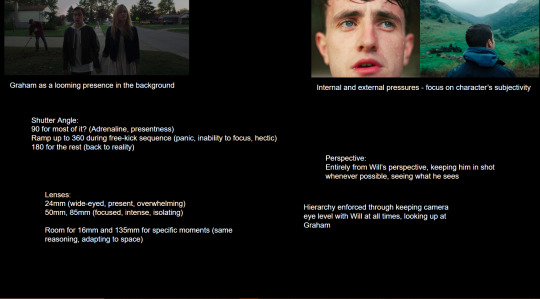
Scrapbookin
At this point, we needed to focus on our pitch deck and presentation which was a useful exercise not just to practice pitching but also to collate all the research and clearly define the approach to the cinematography. I will post the pitch deck next as a summary of the research I have been doing.
4 notes
·
View notes
Note
Watching the playthrough again. The open window tells me how the Host got in, though I almost missed the second camera at the start. Can tell from the path we take that Mortimer giving a Puppet to someone is probably how they deal with curious humans. I wonder if the red arrow is blood or just paint since it is still vibrant. A curtain closes once Mortimer starts talking not to mention him being illuminated. So slight jumpscare and being somewhat blinded by the lights. Debating whether to write the encounter from Mortimer’s perspective or simply have the Puppets review footage.
I do have a name for the vampire. Josephine, who turned age fifteen during the 1930s, tends to go by Josie since her name’s old-fashioned. Might go the route of vampires having normal eye colors until they get emotional. Either being angry, upset, or scared turns them red. Got a little inspired by you to have the puppets be somewhat damaged. Debating on Scout not being canon blue-haired Scout Prime. Most of the felt Puppets were blue or yellow-skinned, so where did Owen get pinkish fabric? I’m guessing the Handeemen keep him comatose nowadays since they are still connected.
I like the nod to SuperHorrorBros theory in your first story. Here’s a little backstory to where I set my one-shot in—even if I end up keeping it as a one-off story; Most Supernatural creatures/entities seen in fiction are real in some way shape or form. There might be general authorities to keep serious magic out of the public’s (normal humans) eyes. On main reason for hiding is that human technology can outnumber even the greatest spell casters. They couldn’t stop say... a nuke or missile. The second is we humans simply outnumber most supernatural beings. Seven billion of us to a few million total of all these different species.
Even if I just write the one-shot with this in mind, I might use the background for another story later on. That’s all for now.
Ooooo yes, this story looks like it's building itself up to something great! Writing the encounter from Mortimer's perspective would be really cool, and depending on how you do it you can also show off his inner thoughts.
Josephine is a really pretty name, and the eye thing also seems really neat :) Choose whichever Scout you want, there is after all four other "canon" looks to choose from, or create your own^^
Tbh I don't really remember which theory you are referring to, it's been a while since I have seen the hello puppets videos from superhorrorbro... But how you plan it with supernatural entities seems like a good choice! Humans outnumbering supernatural creatures do make sense, and the technology we have nowadays is probably stronger than their magical powers.
Hope you have fun with your writing, and thanks for the ask ^^
6 notes
·
View notes
Text
Academic Blog 1
Studio Ghibli movies have always invoked emotions within their viewers. I would like to use affect theory to analyse Ghibli movies and incorporate some techniques or concepts in video games to evoke a similar sense of empathy from the audience. Affect can be frequently seen as something beyond a person, discursive, and relational, as well as reactive and pre-cognitive (Döveling, Harju, 2018). Video games would greatly benefit from improving their ‘affect’ on their audience. By offering players a more immersive experience, they will develop a connection with the characters or the story in the game.
Ghibli movies often incorporate more slow-paced scenes after ones that are high in energy. It could be shots of very simple things such as looking outside a window. These might be scenes that could’ve been cut out or seem like a waste of time yet they have something about them which pulls the viewer in and makes the overall experience all the better. Scenes like these are often referred to as Ma scenes. Weedy (2018) ‘Ma’(the Japanese word for emptiness) in Studio Ghibli is defined as any instance in which a character will just sit for a moment not to advance the story but only to give the sense of time and place and who they are. The emptiness of the scene exists to give the audience the space to process what has happened so far. The viewer gets to project their emotions onto the character within the context of the story and develop a connection with it.
The affect in these movies is achieved through certain techniques. One of them is the perspective and camera placement that results in a view where the audience feels more involved in the scene rather than as an outsider. This can be often seen in train scenes in Ghibli movies. Weedy (2018) supports this by saying that in the train ride scene, when panoramic perception is achieved, the perceptual rupture will cause a heightened focus, and the viewer starts to focus more on Chihiro the protagonist of the film Spirited Away (2001) that they are presented with. Owing to the effective camera placement of the shot and the perspective, the audience can separate themselves from the background and focus their attention on what is important.
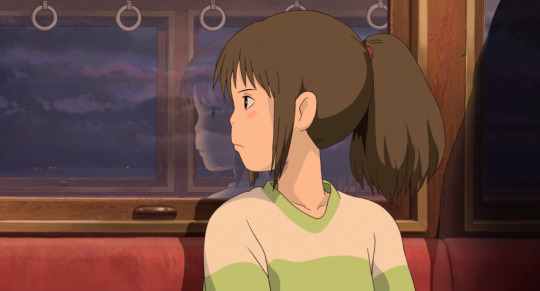
Ryan Ninesling (n.d) Chihiro.png
The viewers are then presented with simple character designs that are like blank slates that they can project themselves onto. The faces are simple enough to be relatable while the outfits of the character remind the viewer of the story. This results in an amplification of the emotions felt by the viewer. Weedy (2018) The act of assigning identities and emotions to entities where it doesn’t exist, creates a space for viewers to project their own identities. This occurs when the viewer is in a focused and contemplative state, which allows them to form an empathetic connection with Chihiro. In turn, Chihiro gains cognitive depth as a character, which the viewer can relate to and empathize with.
Scenes such as the vast landscape or shots of the weather reflecting the character’s emotions in between high-energy shots also help the viewer have time to contemplate what has happened. In video games, the pace is often very fast even in games with cutscenes. As a games artist, I think video games would benefit from implementing some slow-paced shots within the cutscenes to let the player contemplate and feel an emotional bond with the character they are playing. ‘Ma’ scenes like these being implemented in cutscenes will also give the player the option to skip if they prefer. It would make the player experience more fulfilling and valuable while being able to enjoy fast-paced gameplay outside of scenes such as these. Döveling and Harju (2018) claim that emotions are the outcome of particular relational scenarios, where something new is brought to the scenario by each participant that forms the emotion as a fluid moment. Therefore, they will enhance the affect brought about by video games on the player.
References
Döveling, K., Harju, A. A., & Sommer, D. (2018). ‘From Mediatized Emotion to Digital Affect Cultures: New Technologies and Global Flows of Emotion’. Social Media + Society, 4(1). Available from: https://doi.org/10.1177/205630511774314 [Accessed: 1 December 2023].
Ryan Ninesling (2021) Chihiro.png, filmdaze. Available at: https://filmdaze.net/wp-content/uploads/2020/07/chirhiro.png [Accessed: 1 December 2023].
Spirited Away (2001) Directed by Hayao Miyazaki. [Feature film]. Studio Ghibli.
Weedy, K. (2018) ‘Chihiro Boards a Train: Perceptual Modulation in the Films of Studio Ghibli’. in FORUM: University of Edinburgh Postgraduate Journal of Culture & The Arts. [Online] 27 (December). Available from: https://doi.org/10.2218/forum.27.2906 . [Accessed: 1 December 2023].
0 notes
Text
Week Four - Magnus Portraits & Portraits for Blog
Activity 2
Describe the composition of the image
The woman is shot straight-on, allowing us to look directly into the perspective of someone swamped with work. Without an upward-facing angle, there’s no indication she has a position of authority. This implies her position as a low-level assistant or receptionist, as indicated by the ‘memos’ sign. The receptionist is framed to the left, and work to the right. The ‘memos’ memo is framed center right, catching immediate attention, possibly leading viewers to look at the cluttered desk before the woman. It’s worth noting that the ‘memos’ is placed higher than the woman, indicating a sense of ‘living to work’.
How have light and tone been used and what effect does this have?
Color has been actively omitted from this photo. We know color photography was around at this time, as the typewriter implies 1970s. I believe the omission of color omits warmth - consistent with office culture of the time. The factual nature of BW suggests a commentary on female oppression in the office. Pay gaps, sexual harassment, and loads of repetitive tasks. The most exposed or saturated part of the image is the window, preventing us from seeing her office view. Can we see skyscrapers from the top-floor view? Maybe she’s in a position of power being the assistant to eh CEO. It doesn’t seem to matter, because a snapshot of mundane daily tasks doesn’t need more context than ‘memos.’
How has focus been used and what effect does this have?
There seems to be a higher-range aperture, as both the foreground and background are relatively focussed. You can see an equal amount of words on the shelf binders as the desk memos. I believe this choice signals how overwhelming reception work can be. So many important meetings to book, some on the shelf, some hidden under a stack of memos. One slip-up, and it may be difficult to find another reception role.
What does the pose/posture of the person depicted convey about him/her?
The receptionist seems hunched over, indicating low-confidence. Confident subjects have higher chin, with their chest out and strong. The opposite is being shown here. She also is not facing the camera, indicating that she is distracted from the photographer, or being distracted from her work. On the other hand, she did take the time to take her readers off. This could indicate that she feels pressured to look more sexy for the photo.
What is the most interesting aspect of the photo?
I think the most interesting thing about this image are the decorations beside her desk. Through all the stresses of daily work, a glimpse of personality comes through. They look like soccer team badges. Manchester United fan?
What is the mood of the photograph? What creates this mood?
The mood of this image is quite depressing. Without the warm colors of the blue sky, a melancholy falls over the viewer. Nobody wants to be stuck in an office. Her face also seems perplexed or anxious. Not a welcoming smile you’d expect from a receptionist.
Activity 3
Describe the composition of the images
In one of these images, I’ve framed Brooke left, and the Bus stop directions to the right. Similar to how Magnus placed the ‘memos’ sign higher than the receptionist, the bus directions in focus impose upon Brooke. This was an attempt at delivering a similarly overwhelming feeling, as Brooke is new to London. We also see a ‘kidnapped’ sign in the window, further bolstering the anxiety of being a woman in a new city. In the other images, Brooke is framed infront of the directions. Her umbrella comes into frame, blocking out the bus directions and her anxiety. This shows confidence.
How have light and tone been used and what effect does this have?
While I was trying to have the exposure put more focus on her facial expression, it did the opposite. Despite this techincal mishap, I think the many emotions that come with moving to a new city still comes across as confident due to her body language being appropriately lit.
How has focus been used and what effect does this have?
I selected ISO 800 and a mid-ranged shutter speed to avoid having the bus station be blurry. If I’ve done my job correctly, I wanted to show the contrast between the city aspects of a bus stop and the mixed human aspects of being confused or confident in a new environment.
What does the pose/posture of the person depicted convey about him/her?
This was an attempt at focussing on her changing expressions from photo to photo. She starts off confused, becomes increasingly confident, with the most confident look being the most exposed. In the first image, we see scared body language. Hunched back, concerned eyes. In the last image, her shoulders are back, chest out, with a confident face.
What is the most interesting aspect of the photo?
I think the most interesting part of the photo is how her personality changes. Her body language becomes stronger, and this was captured without changing the angle to upward-facing.
What is the mood of the photograph? What creates this mood?
I believe the mood is warmer than the Magnus image. This is largely due to the inclusion of color.
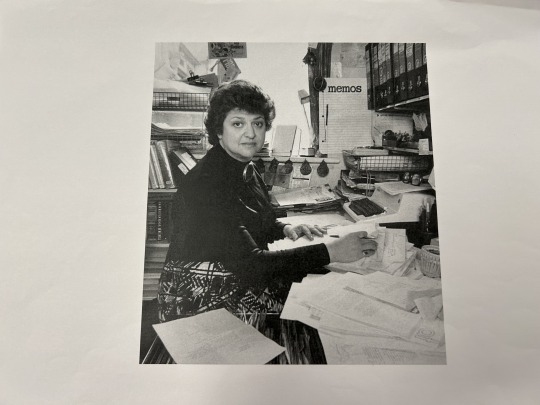
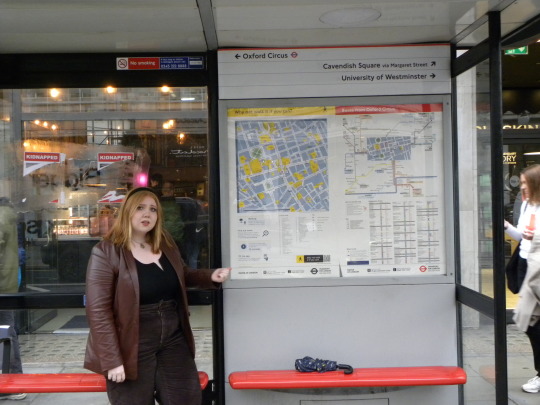
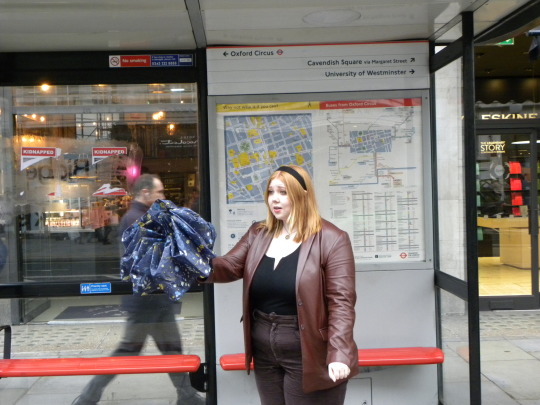
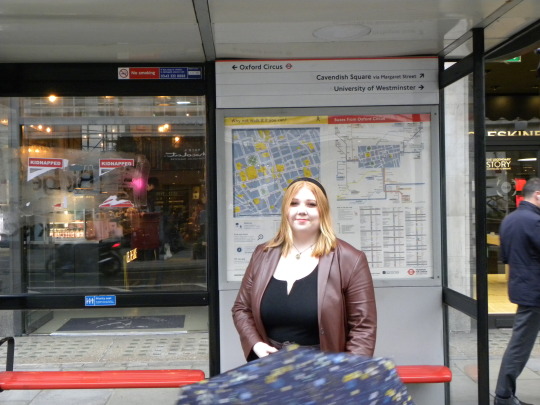
0 notes
Text
I have nowhere to vent this besides here and Quotev so I'm confiding in this damned hellsite for this one.
I have the idea for an almost Junji Ito like short horror comic. I don't know exactly what I'd call it yet, but my beta title for it is 'There She Is'.
It's told from the first person perspective of an 18 year old woman, who explains that when she was younger she was a MASSIVE Supernatural fan, to the point where she would have a reoccurring dream where she was Sam and Dean's sister and she would help them out with hunter business sometimes.
She mentions that she's always been a pretty vivid dreamer, and that she always remembered her dreams. Though by now she's forgotten most of the old ones. Except for one.
The dream started like all of her other Supernatural dreams. Only this time, when she got to the investigation portion, suddenly everyone around her was gone. She was completely by herself, all the characters she was familiar with were gone and she was left in a completely unfamiliar location. As her dream self called for help, it wasn't long before she would run into...her. 'Her' being a tall woman with dark hair. She wears a frilly white dress, black mary janes, and white socks. But the traits that are most noticeable are on her face. Her eyes completely lack pupils or irises, instead having dark inky splotches, almost like a bug's compound eyes. Her mouth abnormally wide in a toothy, gummy smile. And all this woman did was stare at the protagonist until she woke up.
The protagonist would go on to describe how she'd so that woman constantly from then on. In windows, in mirrors, in photographs...But she never was really present. At least not physically.
It's revealed that the protagonist is explaining all of this to a therapist. She says she's never told anybody about this out of fear of being called crazy. After a while she had gotten used to seeing the woman, and she just became another part of the background. Just like she'd see trees, clouds, grass, and concrete, she'd see the woman. She says that she wouldn't mind medication. Even though she has gotten used to it, that doesn't exactly make it pleasant. Just like how the glare of the sun through your windshield may be normal, but that doesn't mean you want it to happen. The therapist says that might be possible, but they'd need to do some future evaluations beforehand, and her session is ended for the day.
The protagonist leaves the building and goes to get her bike, only to realize someone had cut her lock and stolen it. She picks up the cut bike lock and the left behind helmet and begins walking home instead. As she walks she notices tha the streets feel oddly deserted, and the feeling only gets stronger as she keeps going forward.
Until she comes across the street from her dream. Looking around she notices all the similar details, but before panic can set in she sees her. The woman. Only this time she's real. The woman starts laughing but none of her features or her body move with it. She moves in closer, again without really moving. She finally moves, bringing her arms up to the terrified protagonists face and pulls her into a kiss. The final shot of the protagonist is of her eye, rolling back into her skull before developing the same inky splotches.
It switches to a different girl, around 15 years old. She's walking home from school and listening to a horror podcast. She stops to take a selfie, but when she checks the picture after the fact.
She sees what was once our protagonist, now appearing like the woman she had feared.
And that's the whole thing. I have no idea if I really want to turn this into an actual comic, but I'm genuinely considering it. It's probably the first time I have an entire story planned start to finish, even a short story. For once I actually have a middle to it haha. I'm going to try and grab some printer paper from somewhere in my school to start working on it.
#short horror story#author#junji ito#supernatural#it is 8:33 in the morning literally how#this is what little sleep and being gay does to a man
0 notes
Text
Hexio plus drone

#HEXIO PLUS DRONE SOFTWARE#
#HEXIO PLUS DRONE BLUETOOTH#
More details are available on What?’s Web site. But with its handsome leather strap and pretty analog face, the What? has turned some heads in the few days I've been wearing it. Most people never ask me about my Apple ( AAPL) Apple Watch. The small team of engineers hails from a wide variety of geographic backgrounds including Finnish and Italian. The watch assemblies are made by a firm in Switzerland with a long history in the business. I imagine that can be fine tuned over time.įor Igor Basargin, who is Russian, What? is a nice change of pace from his prior life as a lawyer.
#HEXIO PLUS DRONE SOFTWARE#
It's a bit of a gimmick, and the software seems to involve too many steps to save a moment. On the watch face itself, the little dots of e-ink turn from grey to black to indicate you've got a moment in the month of September.
#HEXIO PLUS DRONE BLUETOOTH#
When you press the red button on the side of the watch, it uses Bluetooth wireless to tell the app on your smartphone to create a "moment." Basically, it's just a time stamp that opens a round window in the app for your to take a picture or a selfie commemorating that moment in time. The watch is a solid-feeling metal piece, with an elegant white or black face that is mostly traditional analog except for a layer of e-ink underneath the surface. I had attended their unveiling on Sunday at the Wythe Hotel in Brooklyn, where the company had rented out the rooftop for a view of the lunar eclipse. The docents are always dressed in some kind of interesting garb, and this season seemed to be vaguely spooky Elizabethan gowns.Īmong wearables, the Austrian firm What? was showing off a smartwatch that is getting lots of looks. Wednesday night's show was well attended, with guests noshing on hors d'ouevres, sipping wine, and kicking the tires. H ttps://startups have novel inventions that work with your smartphone across a range of product categories from smart lighting to wearables to drones to toys. If we reach our goal it’ll mean that there is a real need for HEXO+ and you’ll be the signal for that, so thanks in advance for your support. We’re putting the project in the hands of the Kickstarter community because it is the best way to be directly in touch with the users of our product and build this together. This accounts for $50k, the smallest budget we believe is necessary to make HEXO+ a reality, and starting at $499 apiece, an affordable one.īut that’s not all. We need to pay for molds, minimum orders on parts and build. Now, taking the leap to industrial production requires funds that we can’t secure without your help. Why? Because they would all love to have a tool like HEXO+. Our strong historical ties with the action sports community have given us extensive access to athletes and filmmakers and everyone is willing to support HEXO+. The shots we obtained are just awesome and that’s what matters. The drone is fast and agile, and the flight controller as responsive as we want it to be – from our action sport movie-making people perspective. What we’ve done so far is take our initial idea to the stage of a working prototype: we’ve been ramming through hardware and software hurdles until last month, when we managed to consistently make our prototype work in field conditions. We also integrated over the air gimbal control to obtain the best possible camera angle based on the relative positions of the drone and the subject. The onboard software is based on the 3D Robotics open-source code, and we optimised the MAVLINK implementation and the behavior of the drone to improve response time to commands sent from the mobile app. On the drone side of things, we have combined a drone that’s designed and optimised for aerial filming and action sports: robust construction, payload capacity and high speed and stability, thanks to the six tilted propellers. Finally, the smartphone and the drone communicate relative position to each other and data over the MAVLINK protocol, developed by the ETH in Zürich. This enables a quick, accurate tracking of the subject and is key in achieving great images. This user interface is backed by trajectory anticipation algorithms that crunch data coming from the sensors on the drone and smartphone to predict the next, most likely position of the subject. On the smartphone side we have an intuitive interface for you to handle your drone easily, position it where you want in space and potentially (stretch goal!) wifi video live feed. Our team has strong roots in critical aeronautic software development and that made HEXO+ possible. You might think this is borderline magic, but it’s actually all orchestrated by a smart and lean use of technology.

0 notes
Text
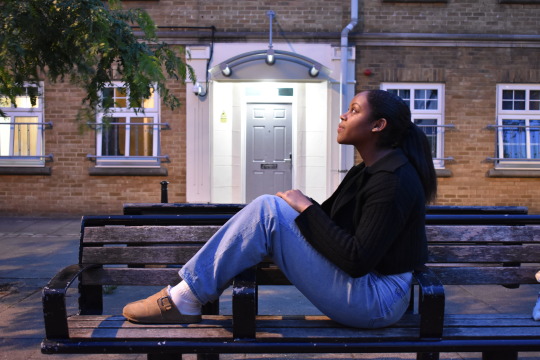
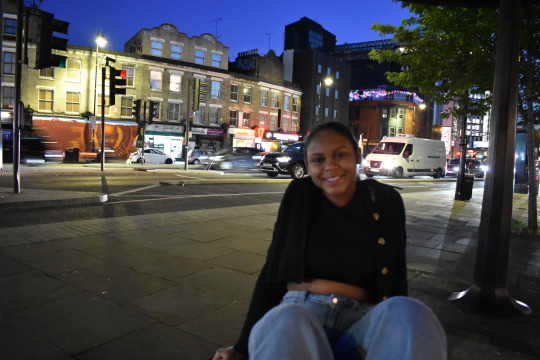
Partner shoot
The 1st photo was directed by me. I knew I wanted her picture to be more candid in the way she interacted with the camera. I wanted her sitting on the bench so I could get a full body shot and a sense of the surrounding area. In terms of the background, I liked how there was a tree branch hanging down, almost as if it was making eye contact with Tiana, like she had some sort of connection with nature. For how her body was posed, I wanted her legs and arms to be close to each other and not sprawled out. I liked the limbs close together because it had more of a cohesive feel. I wanted her face to look upwards to get more light on her. I decided to have her directly centered because it allowed her to fill the frame more. My favorite things about this photo are her body position and the slightly blue tint. I also like the repetition of the windows in the background.
The 2nd photo was directed by Tiana. She chose the location, pose, and expression. It was up to me how I wanted to capture this. I didn’t have time to get a picture that I’m proud of because we almost got one of the cameras stolen and that was a sign that we should stop taking pictures for the night. I decided to frame her to the side so the viewer could see the cars in the back and have a sense of motion. In the perfect world, Tiana would be in the focus and I would have captured blurred motion on the cars behind her. Perspective wise, I decided to get a little higher than Tiana to showcase the background more. The lights in the background gave an interesting feel to the picture and really showcased the nightlife.
This experience was fun, we had a bit of a later start so we got to experiment with night photography, we used flash, played with settings, and tried different locations near where we live. I feel like I would’ve done better if we shot during the daytime but with the amount of time we had, I liked how the first photo came out. The three facts I learned about Tiana were: She’s been to 5 countries, she collects crystals, and she has an irrational fear of ketchup.
1 note
·
View note
Text
Architecture- Research Task 1
These first 3 images are by Architectural photographer Matt Livley.

^ First we have an amazing photograph of what appears to be some sort of tropical hotel resort. There is no information on his website however to confirm this. He has chosen to take these images at dusk, just after the sun has set which I think was a very purposeful and well thought out decision. The dark blue of the sky makes the building really stand out because of its yellow-tinted stone work. Orange and blue are contrasting colours making the building pop out from its background perfectly. I like the wide shot of the building, it shows it’s scale and relation with its surroundings. I think this enhances the architects vision as its taken from the position a person may see when approaching the building. It also appears that the architect wanted a less modern, more wild or culturally relevant look. Maybe wherever this building is situated is a place where this style reflects the history and or culture. It also includes a lot of foreign greenery which only enhances this tropical, get-away feel, and the photographer has managed to include and show off these aspects.

^ Lively then took this detail shot of an interior of a building. Again there is no information attached to this image so I can’t say for sure what it’s purpose is. The photographer has specifically chosen to photograph this space on a bright sunny day. It appears that they’ve gotten a window that’s exactly opposite the sun which is letting lots of light to flood in, which means that at a time when the sun is brightest, say 11am-1pm, it causes the glossy floors and white walls to shine bright white, instead of a dull or murky yellow. The photographer has taken full advantage of this and manages to enhance the photographers vision by showing off the geometric shadow patterns created by the windows and wall pillars. I find this to be very visually appealing as patterns are very eye catching and interesting to look at. The repetition captured is very pleasing to the eye.

^ Finally, the last of my chosen Matt lovely photos. We have a tall, office like building. The reason I liked this image is because of its balance. He has decided to purposely capture or crop the image in a way that has the building take up exactly one half of the image and the sky take up the other half. This is very visually appealing as the building on the left has lots and lots of repeating geometric shapes again, making it appear busy and crowded. Then in contrast, the right hand side is empty and flat, with nothing happening. It appears much more quiet. I think this is successful because it draws all of the attention onto the building, making us look at its details. It also helps show the scale of the building, which the architect would have obviously decided and thought about. Lively has taken the image from a high up perspective because we can’t see any ground or other buildings, suggesting to us that this building is very tall.
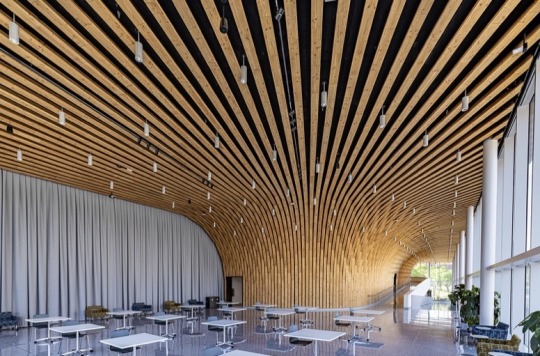
^This and the next two images are by photographer David Keith. This image appears very abstract in my opinion. The repeating lines leading down through curves connecting to the walls is very confusing on the eyes, it almost appears like an optical illusion. This is very eye catching and definitely a feature the architect wanted to be noticed. Keith enhances this by photographing the room the way he does. Using a wide angle lens and a higher viewpoint he gets most of the room in view, including the curling. This means that the rows of wood bring in from each angle of the top of the frame and lead all the way to the other side of the room. This only helps to show the grand scale of room, a very important feature the architect would have wanted to be represented. The lighting has also played a part in this, the huge floor to ceiling windows have been included which lets the light flood in and illuminate all of the room, this way we can see it’s true size. The light also shows off the pattern of the roof as the wood is illuminated but the shadows between remain dark, creating a striking pattern that catches our eyes.

^The second image which I found interesting of David Keith was of this interior lighting fixture. I think this shows off the space and features pretty well, although I do have some things that I would change. I think it works really well in the sense that the lights flow from the bottom right up to the top left of the image frame, leading your eyes through the picture. This is beneficial as you notice other things that the architect would have wanted you to, for example the large windows in the background let in lots of natural light. However I might of either zoomed out or step back to see more of the floor and stair case as they are important features. As well as this, I think photographing at dusk or just before would still be able to show the large windows, as well as flatter the lighting fixture when it’s illuminated. I think this is quite impressive because Keith would have had to do some compositing through the different types of lighting in the image. This would mean he would’ve done some compositing in post production class high takes a lot of practice and skill.

^ This third and final image I was drawn to by David Keith is really technically impressive. Like the last, there are lots of different sources of light coming from all over the room. Keith has decided to show off the architects vision by having all of the artificial lights on. This means that he would have had to do a lot of compositing within the images. Shooting at different white balances and exposures to account for the window and lamp lights, as well as making sure the darker parts of the room stay well lit too. I do like that the photographer has chosen to shoot during day light, to again show off the architects vision of the large windows pouring in so much light. It’s obviously a very defining feature of the room and needed to be represented.

^ I found this image on the ‘The Best of Arcaid Images Architectural Photography Awards 2017’ page. This is the Bosjes Chapel in Capetown, South Africa, photographed by Adam Letch. What drew me to this image is the building soft, curving shapes and beautiful lighting qualities. Letch has purposely placed the entire building in frame, centrally so to create symmetry which is very pleasing to the eye. He has also taken the image from a far away view point, which lets us see the path leading up to the Chapel, something clearly thought out by the architect as it features the two pools of water on either side, a very important feature that needed to be included. Letch has decided to photograph the chapel at what appears to be dusk so to show the full effect of the lighting fixtures and how the illuminate and enhance the buildings lines and shapes. He has also photographed the chapel, leaving some background in to show where it’s situated, how it blends, or maybe doesn’t, into the scenery.
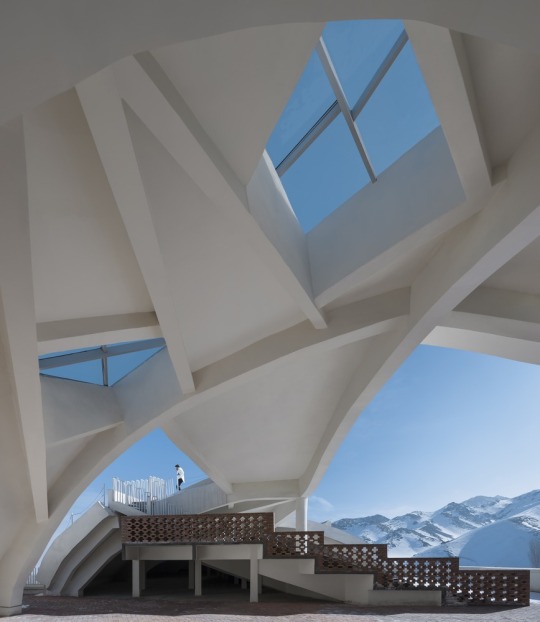
^ another photograph found on ‘The Best of Arcaid Images Architectural Photography Awards 2017’ website. This is by photographer Yao Li and is of the Xinjiang Wind Architectural Design & Research Institute in China. There is no denying that this building is abstract, which is what initially drew me into it in the first place. All of the structural lines and shapes make it very confusing yet attention grabbing, you can’t help but to look up. Li has shown the architects vision by using a different wide angle lens which shows the ground, walls and ceiling, as well as the large open walls. These are very important features of this building, something that you don’t normally see in many cities or places. I think that Li has managed to enhance the visions of the architect perfectly by not only showing the features of the institute, but also having a person interact with it. By having the person placed in the image, it gives us an idea of the grand scale of the building, making it all that more impressive as we realise just how huge the open gap walls and abstract ceilings are.
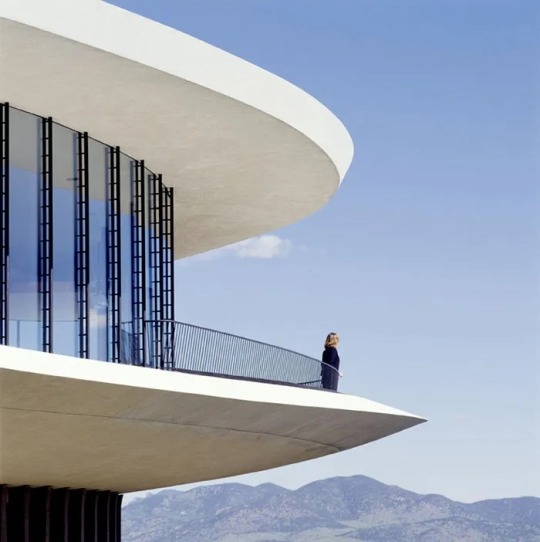
^ This image is a perfect example of human interaction within architecture. The unknown photographer has used skills of composition to place the building 2/3 of the way in frame to make sure that it is the main focus of the image, whilst also ensuring to capture and place the person on a point of intersection, drawing focus to them as well. I think it’s important that the photographer has chosen to include a person in view as it shows how people can interact with the building. As I read somewhere, architecture is about the people, not the building.
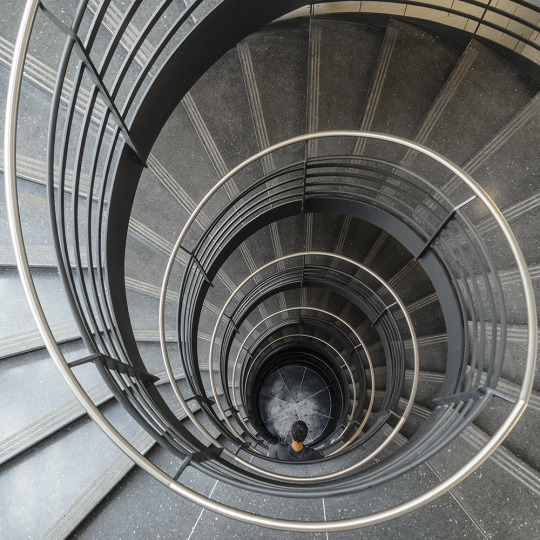
^ Again, this image comes from an unknown photographer but I think it shows the relationship between people and architecture really well. They have photographed from a birds eye point of view which gives an idea into the sort of scale of the staircase, whilst also creating pattern which as I previously talked about, is very visually appealing. They’ve decided to photograph during daylight, which lets us and anyone else see what it looks like to have the natural light spill onto the stairs, which is obviously very important so people can see where they step. The aspect of people and architecture, it shows how a person can interact with the space, they can hold onto the railings in place, which can be seen by the person in the image, as well as look up and down through the space in the middle of the spiral, which has been a conscious decision of the architect as they could easily have closed it off. The photographer has done a great job showing this within the image.
0 notes